This video accompanies a blog post of the same title. The content is mostly the same; the blog post contains a few extra elements (especially in the footnotes!). Enjoy whichever one you choose.
Also available on YouTube and on Facebook.
This post is also available as an article. So if you'd rather read a conventional blog post of this content, you can!
This video accompanies a blog post of the same title. The content is mostly the same; the blog post contains a few extra elements (especially in the footnotes!). Enjoy whichever one you choose.
Also available on YouTube and on Facebook.
This post is also available as a video. If you'd prefer to watch/listen to me talk about this topic, give it a look.
This blog post is also available as a video. Would you prefer to watch/listen to me tell you about the video game that had the biggest impact on my life?
Of all of the videogames I’ve ever played, perhaps the one that’s had the biggest impact on my life1 was: Werewolves and (the) Wanderer.2
This simple text-based adventure was originally written by Tim Hartnell for use in his 1983 book Creating Adventure Games on your Computer. At the time, it was common for computing books and magazines to come with printed copies of program source code which you’d need to re-type on your own computer, printing being significantly many orders of magnitude cheaper than computer media.3
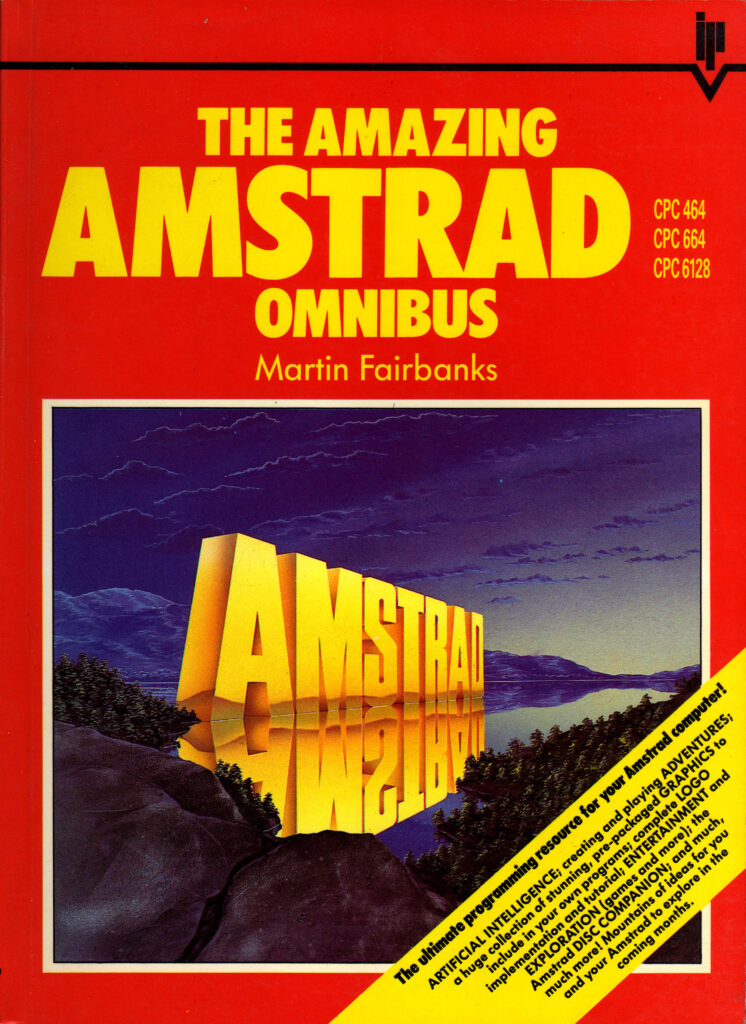
I’d been working my way through the operating manual for our microcomputer, trying to understand it all.5
![Scan of a ring-bound page from a technical manual. The page describes the use of the "INPUT" command, saying "This command is used to let the computer know that it is expecting something to be typed in, for example, the answer to a question". The page goes on to provide a code example of a program which requests the user's age and then says "you look younger than [age] years old.", substituting in their age. The page then explains how it was the use of a variable that allowed this transaction to occur.](https://bcdn.danq.me/_q23u/2023/07/cpc664-manual-input-command.png)
[ENTER] at the end of each line.
In particular, I found myself comparing Werewolves to my first attempt at a text-based adventure. Using what little I’d grokked of programming so far, I’d put together
a series of passages (blocks of PRINT statements6)
with choices (INPUT statements) that sent the player elsewhere in the story (using, of course, the long-considered-harmful GOTO statement), Choose-Your-Own-Adventure style.
Werewolves was… better.
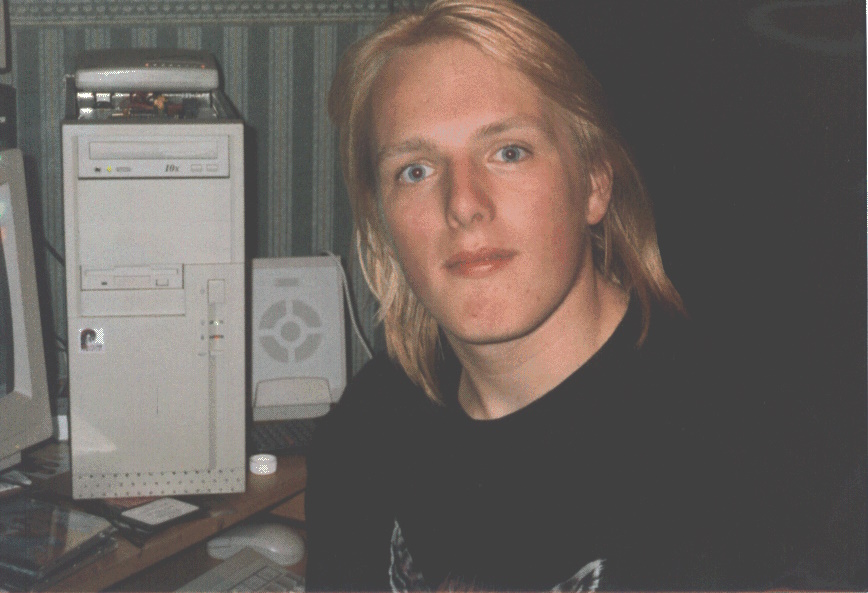
Werewolves and Wanderer was my first lesson in how to structure a program.
Let’s take a look at a couple of segments of code that help illustrate what I mean (here’s the full code, if you’re interested):
10 REM WEREWOLVES AND WANDERER 20 GOSUB 2600:REM INTIALISE 30 GOSUB 160 40 IF RO<>11 THEN 30 50 PEN 1:SOUND 5,100:PRINT:PRINT "YOU'VE DONE IT!!!":GOSUB 3520:SOUND 5,80:PRINT "THAT WAS THE EXIT FROM THE CASTLE!":SOUND 5,200 60 GOSUB 3520 70 PRINT:PRINT "YOU HAVE SUCCEEDED, ";N$;"!":SOUND 5,100 80 PRINT:PRINT "YOU MANAGED TO GET OUT OF THE CASTLE" 90 GOSUB 3520 100 PRINT:PRINT "WELL DONE!" 110 GOSUB 3520:SOUND 5,80 120 PRINT:PRINT "YOUR SCORE IS"; 130 PRINT 3*TALLY+5*STRENGTH+2*WEALTH+FOOD+30*MK:FOR J=1 TO 10:SOUND 5,RND*100+10:NEXT J 140 PRINT:PRINT:PRINT:END ... 2600 REM INTIALISE 2610 MODE 1:BORDER 1:INK 0,1:INK 1,24:INK 2,26:INK 3,18:PAPER 0:PEN 2 2620 RANDOMIZE TIME 2630 WEALTH=75:FOOD=0 2640 STRENGTH=100 2650 TALLY=0 2660 MK=0:REM NO. OF MONSTERS KILLED ... 3510 REM DELAY LOOP 3520 FOR T=1 TO 900:NEXT T 3530 RETURN
...) have been added for readability/your convenience.
What’s interesting about the code above? Well…
GOSUB statements):
2610), the RNG (2620), and player
characteristics (2630 – 2660). This also makes it easy to call it again (e.g. if the player is given the option to “start over”). This subroutine
goes on to set up the adventure map (more on that later).
160: this is the “main game” logic. After it runs, each time, line 40 checks IF RO<>11 THEN 30. This tests
whether the player’s location (RO) is room 11: if so, they’ve exited the castle and won the adventure. Otherwise, flow returns to line 30 and the “main
game” subroutine happens again. This broken-out loop improving the readability and maintainability of the code.8
3520). It just counts to 900! On a known (slow) processor of fixed speed, this is a simpler way to put a delay in than
relying on a real-time clock.
The game setup gets more interesting still when it comes to setting up the adventure map. Here’s how it looks:
2680 REM SET UP CASTLE 2690 DIM A(19,7):CHECKSUM=0 2700 FOR B=1 TO 19 2710 FOR C=1 TO 7 2720 READ A(B,C):CHECKSUM=CHECKSUM+A(B,C) 2730 NEXT C:NEXT B 2740 IF CHECKSUM<>355 THEN PRINT "ERROR IN ROOM DATA":END ... 2840 REM ALLOT TREASURE 2850 FOR J=1 TO 7 2860 M=INT(RND*19)+1 2870 IF M=6 OR M=11 OR A(M,7)<>0 THEN 2860 2880 A(M,7)=INT(RND*100)+100 2890 NEXT J 2910 REM ALLOT MONSTERS 2920 FOR J=1 TO 6 2930 M=INT(RND*18)+1 2940 IF M=6 OR M=11 OR A(M,7)<>0 THEN 2930 2950 A(M,7)=-J 2960 NEXT J 2970 A(4,7)=100+INT(RND*100) 2980 A(16,7)=100+INT(RND*100) ... 3310 DATA 0, 2, 0, 0, 0, 0, 0 3320 DATA 1, 3, 3, 0, 0, 0, 0 3330 DATA 2, 0, 5, 2, 0, 0, 0 3340 DATA 0, 5, 0, 0, 0, 0, 0 3350 DATA 4, 0, 0, 3, 15, 13, 0 3360 DATA 0, 0, 1, 0, 0, 0, 0 3370 DATA 0, 8, 0, 0, 0, 0, 0 3380 DATA 7, 10, 0, 0, 0, 0, 0 3390 DATA 0, 19, 0, 8, 0, 8, 0 3400 DATA 8, 0, 11, 0, 0, 0, 0 3410 DATA 0, 0, 10, 0, 0, 0, 0 3420 DATA 0, 0, 0, 13, 0, 0, 0 3430 DATA 0, 0, 12, 0, 5, 0, 0 3440 DATA 0, 15, 17, 0, 0, 0, 0 3450 DATA 14, 0, 0, 0, 0, 5, 0 3460 DATA 17, 0, 19, 0, 0, 0, 0 3470 DATA 18, 16, 0, 14, 0, 0, 0 3480 DATA 0, 17, 0, 0, 0, 0, 0 3490 DATA 9, 0, 16, 0, 0, 0, 0
DATA statements form a “table”.
What’s this code doing?
2690 defines an array (DIM) with two dimensions9
(19 by 7). This will store room data, an approach that allows code to be shared between all rooms: much cleaner than my first attempt at an adventure with each room
having its own INPUT handler.
2700 through 2730 populates the room data from the DATA blocks. Nowadays you’d probably put that data in a
separate file (probably JSON!). Each “row” represents a room, 1 to 19. Each “column” represents the room you end up
at if you travel in a given direction: North, South, East, West, Up, or Down. The seventh column – always zero – represents whether a monster (negative number) or treasure
(positive number) is found in that room. This column perhaps needn’t have been included: I imagine it’s a holdover from some previous version in which the locations of some or all of
the treasures or monsters were hard-coded.
2850 selects seven rooms and adds a random amount of treasure to each. The loop beginning on line 2920 places each of six
monsters (numbered -1 through -6) in randomly-selected rooms. In both cases, the start and finish rooms, and any room with a treasure or monster, is
ineligible. When my 8-year-old self finally deciphered what was going on I was awestruck at this simple approach to making the game dynamic.
2970 – 2980), replacing any treasure or monster already there: the Private Meeting Room (always
worth a diversion!) and the Treasury, respectively.
2740 is cute, and a younger me appreciated deciphering it. I’m not convinced it’s necessary (it sums all of the values in
the DATA statements and expects 355 to limit tampering) though, or even useful: it certainly makes it harder to modify the rooms, which may undermine
the code’s value as a teaching aid!
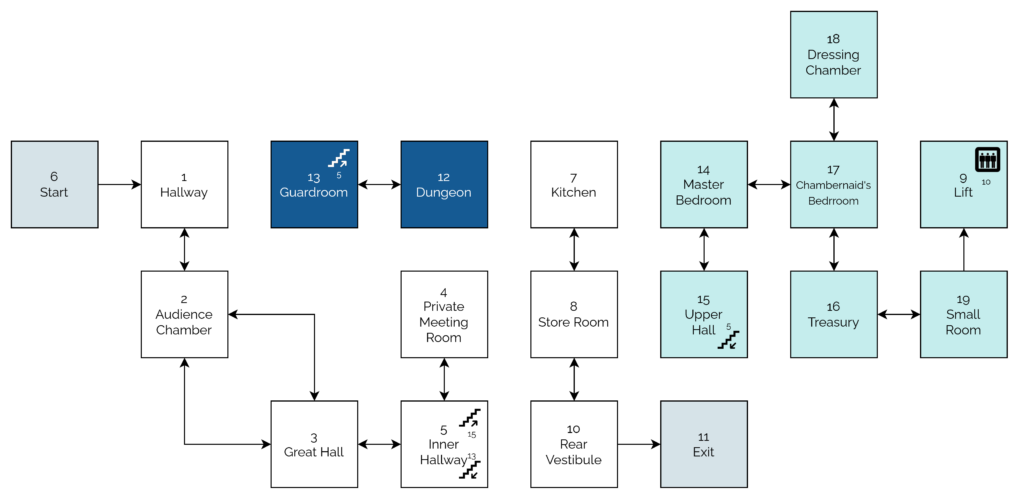
Something you might notice is missing is the room descriptions. Arrays in this language are strictly typed: this array can only contain integers and not strings. But there are other reasons: line length limitations would have required trimming some of the longer descriptions. Also, many rooms have dynamic content, usually based on random numbers, which would be challenging to implement in this way.
As a child, I did once try to refactor the code so that an eighth column of data specified the line number to which control should pass to display the room description. That’s
a bit of a no-no from a “mixing data and logic” perspective, but a cool example of metaprogramming before I even knew it! This didn’t work, though: it turns out you can’t pass a
variable to a Locomotive BASIC GOTO or GOSUB. Boo!10
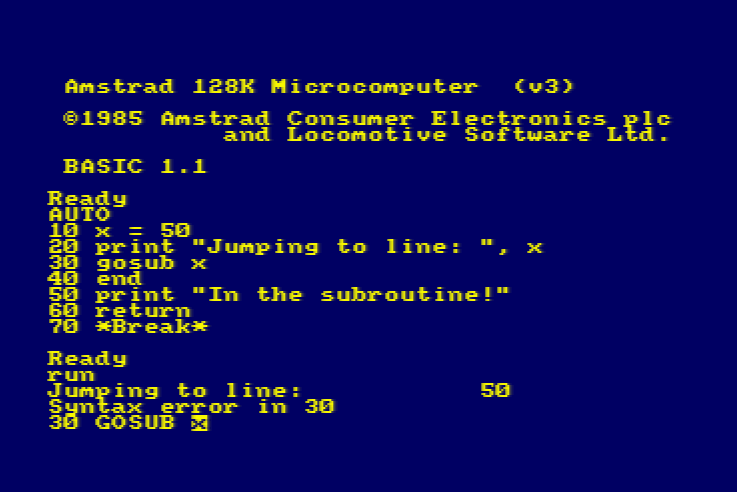
Werewolves and Wanderer has many faults11. But I’m clearly not the only developer whose early skills were honed and improved by this game, or who hold a special place in their heart for it. Just while writing this post, I discovered:
A decade or so later, I’d be taking my first steps as a professional software engineer. A couple more decades later, I’m still doing it.
And perhaps that adventure -the one that’s occupied my entire adult life – was facilitated by this text-based one from the 1980s.
1 The game that had the biggest impact on my life, it might surprise you to hear, is not among the “top ten videogames that stole my life” that I wrote about almost exactly 16 years ago nor the follow-up list I published in its incomplete form three years later. Turns out that time and impact are not interchangable. Who knew?
2 The game is variously known as Werewolves and Wanderer, Werewolves and
Wanderers, or Werewolves and the
Wanderer. Or, on any system I’ve been on, WERE.BAS, WEREWOLF.BAS, or WEREWOLV.BAS, thanks to the CPC’s eight-point-three filename limit.
3 Additionally, it was thought that having to undertake the (painstakingly tiresome) process of manually re-entering the source code for a program might help teach you a little about the code and how it worked, although this depended very much on how readable the code and its comments were. Tragically, the more comprehensible some code is, the more long-winded the re-entry process.
4 The CPC’s got a fascinating history in its own right, but you can read that any time.
5 One of my favourite features of home microcomputers was that seconds after you turned them on, you could start programming. Your prompt was an interface to a programming language. That magic had begun to fade by the time DOS came to dominate (sure, you can program using batch files, but they’re neither as elegant nor sophisticated as any BASIC dialect) and was completely lost by the era of booting directly into graphical operating systems. One of my favourite features about the Web is that it gives you some of that magic back again: thanks to the debugger in a modern browser, you can “tinker” with other people’s code once more, right from the same tool you load up every time. (Unfortunately, mobile devices – which have fast become the dominant way for people to use the Internet – have reversed this trend again. Try to View Source on your mobile – if you don’t already know how, it’s not an easy job!)
6 In particular, one frustration I remember from my first text-based adventure was that I’d been unable to work around Locomotive BASIC’s lack of string escape sequences – not that I yet knew what such a thing would be called – in order to put quote marks inside a quoted string!
7 “Screen editors” is what we initially called what you’d nowadays call a “text editor”: an application that lets you see a page of text at the same time, move your cursor about the place, and insert text wherever you feel like. It may also provide features like copy/paste and optional overtyping. Screen editors require more resources (and aren’t suitable for use on a teleprinter) compared to line editors, which preceeded them. Line editors only let you view and edit a single line at a time, which is how most of my first 6 years of programming was done.
8 In a modern programming language, you might use while true or similar for a
main game loop, but this requires pushing the “outside” position to the stack… and early BASIC dialects often had strict (and small, by modern standards) limits on stack height that
would have made this a risk compared to simply calling a subroutine from one line and then jumping back to that line on the next.
9 A neat feature of Locomotive BASIC over many contemporary and older BASIC dialects was its support for multidimensional arrays. A common feature in modern programming languages, this language feature used to be pretty rare, and programmers had to do bits of division and modulus arithmetic to work around the limitation… which, I can promise you, becomes painful the first time you have to deal with an array of three or more dimensions!
10 In reality, this was rather unnecessary, because the ON x GOSUB command
can – and does, in this program – accept multiple jump points and selects the one
referenced by the variable x.
11 Aside from those mentioned already, other clear faults include: impenetrable controls unless you’ve been given instuctions (although that was the way at the time); the shopkeeper will penalise you for trying to spend money you don’t have, except on food, presumably as a result of programmer laziness; you can lose your flaming torch, but you can’t buy spares in advance (you can pay for more, and you lose the money, but you don’t get a spare); some of the line spacing is sometimes a little wonky; combat’s a bit of a drag; lack of feedback to acknowledge the command you enterted and that it was successful; WHAT’S WITH ALL THE CAPITALS; some rooms don’t adequately describe their exits; the map is a bit linear; etc.
This is a repost promoting content originally published elsewhere. See more things Dan's reposted.
This was a delightful vlog. It really adds personality to what might otherwise have been a story only about technology and history.
I subscribed to Codex’s vlog like… four years ago? He went dark soon afterwards, but thanks to the magic of RSS, I got notified as soon as he came back from his hiatus.
The week before last I had the opportunity to deliver a “flash talk” of up to 4 minutes duration at a work meetup in Vienna, Austria. I opted to present a summary of what I’ve learned while adding support for Finger and Gopher protocols to the WordPress installation that powers DanQ.me (I also hinted at the fact that I already added Gemini and Spring ’83 support, and I’m looking at other protocols). If you’d like to see how it went, you can watch my flash talk here or on YouTube.
If you love the idea of working from wherever-you-are but ocassionally meeting your colleagues in person for fabulous in-person events with (now optional) flash talks like this, you might like to look at Automattic’s recruitment pages…
The presentation is a shortened, Automattic-centric version of a talk I’ll be delivering tomorrow at Oxford Geek Nights #53; so if you’d like to see it in-person and talk protocols with me over a beer, you should come along! There’ll probably be blog posts to follow with a more-detailed look at the how-and-why of using WordPress as a CMS not only for the Web but for a variety of zany, clever, retro, and retro-inspired protocols down the line, so perhaps consider the video above a “teaser”, I guess?
You don’t really see it any more, but: if you downloaded some media player software a couple of decades ago, it’d probably appear in a weird-shaped window, and I’ve never understood why.
 Mostly, these designs are… pretty ugly. And for what? It’s also worth noting that this kind of design can be found in all kinds of applications, in media players that
it was almost ubiquitous.
Mostly, these designs are… pretty ugly. And for what? It’s also worth noting that this kind of design can be found in all kinds of applications, in media players that
it was almost ubiquitous.
You might think that they’re an overenthusiastic kind of skeuomorphic design: people trying to make these players look like their physical analogues. But hardware players were still pretty boxy-looking at this point, either because of the limitations of their data storage1. By the time flash memory-based portable MP3 players became commonplace their design was copying software players, not the other way around.
So my best guess is that these players were trying to stand out as highly-visible. Like: they were things you’d want to occupy a disproportionate amount of desktop space. Maybe other people were listening to music differently than me… but for me, back when screen real estate was at such a premium2, a music player’s job was to be small, unintrusive, and out-of-the-way.

It’s a mystery to me why anybody would (or still does) make media player software or skins for them that eat so much screen space, frequently looking ugly while they do so, only to look like a hypothetical hardware device that wouldn’t actually become commonplace until years after this kind of player design premiered!
Maybe other people listened to music on their computer differently from me: putting it front and centre, not using their computer for other tasks at the same time. And maybe for these people the choice of player and skin was an important personalisation feature; a fashion statement or a way to show off their personal identity. But me? I didn’t get it then, and I don’t get it now. I’m glad that this particular trend seems to have died and windows are, for the most part, rounded rectangles once more… even for music player software!
1 A walkman, minidisc player, or hard drive-based digital music device is always going to look somewhat square because of what’s inside.
2 I “only” had 1600 × 1200 (UXGA) pixels on the very biggest monitor I owned before I went widescreen, and I spent a lot of time on monitors at lower resolutions e.g. 1024 × 768 (XGA); on such screens, wasting space on a music player when you’re mostly going to be listening “in the background” while you do something else seemed frivolous.
The finger protocol, first standardised way back in 1977, is a lightweight directory system
for querying resources on a local or remote shared system. Despite barely being used today, it’s so well-established that virtually every modern desktop operating system – Windows,
MacOS, Linux etc. – comes with a copy of finger, giving it a similar ubiquity to web browsers! (If you haven’t yet, give it a go.)
If you were using a shared UNIX-like system in the 1970s through 1990s, you might run finger to see who else was logged on at the same time as you, finger
chris to get more information about Chris, or finger alice@example.net to look up the details of Alice on the server example.net. Its ability to transcend the
boundaries of different systems meant that it was, after a fashion, an example of an early decentralised social network!
I first actively used finger when I was a student at Aberystwyth University. The shared central computers osfa and
osfb supported it in what was a pretty typical way: users could add a .plan and/or .project file to their home directory and the contents of these
would be output to anybody using finger to look up that user, along with other information like what department they belonged to. I’m simulating from memory so this won’t be remotely
accurate, but broadly speaking it looked a little like this –
$ finger dlq9@aber.ac.uk
Login: dlq9 Name: Dan Q
Directory: /users/9/d/dlq9 Department: Computer Science
Project:
Working on my BEng Software Engineering.
Plan:
_______
---' ____)____
______) Finger me!
_____)
(____)
---.__(___)
It’s not just about a directory of people, though: you could finger printers to see what their queues were like, finger a time server to ask what time it was,
finger a vending machine to see what drinks it
had available… even finger for a weather forecast where you are (this one still works as shown below; try it for your own location!) –
$ finger oxford@graph.no
-= Meteogram for Oxford, Oxfordshire, England, United Kingdom =-
'C Rain (mm)
12
11
10 ^^^=--=--
9^^^ ===
8 ^^^=== ====== ^^^
7 ====== ===============^^^ =--
6 =--=-----
5
4
3 | | | | | | | 1 mm
17 18 19 20 21 22 23 18/11 02 03 04 05 06 07_08_09_10_11_12_13_14 Hour
W W W W W W W W W W W W W W W W W W W W W W Wind dir.
6 6 7 7 7 7 7 7 6 6 6 5 5 4 4 4 4 5 6 6 5 5 Wind(m/s)
Legend left axis: - Sunny ^ Scattered = Clouded =V= Thunder # Fog
Legend right axis: | Rain ! Sleet * Snow
If you’d just like to play with finger, then finger.farm is a great starting point. They provide free finger hosting and they’re easy to use (try
finger dan@finger.farm to find me!). But I had something bigger in mind…
What if you could finger my blog. I.e. if you ran finger blog@danq.me you’d see a summary of some of my recent posts, along with additional
addresses you could finger to read the full content of each. This could be the world’s first finger-to-WordPress gateway; y’know, for
if you thought the world needed such a thing. Here’s how I did it:
efingerd; I’m using the Debian binaries.
ufw allow 1965; utf reload).
efingerd acts like a “typical” finger server, but it’s highly programmable to make it “smarter”. I:
/etc/efingerd/list to prevent any output from “listing” the server (finger @danq.me).
/etc/efingerd/list and /etc/efingerd/nouser(which are run when a request matches, or doesn’t match, a user account name) with
a call to my script: /usr/local/bin/finger-to-wordpress "$3". $3 holds the username that was requested, so we can act on it.
/usr/local/bin/finger-to-wordpress – a Ruby program that either (a) lists a selection of posts or (b) returns a specific post (stripping the HTML
tags)
In future, I might use some extra tags or metadata to enhance finger-friendly WordPress posts. The infrastructure’s in place already (I already have tags that I use to make
certain kinds of content available only via certain media – shh!). You might rightly as what the point is of this entire enterprise, of course, and you’d be well within your
rights to ask such a question. But I think the best answer available is “because Dan”.
If you want to see my blog in a whole new way, give it a go: run finger blog@danq.me on your computer and follow the instructions.
This post is also available as a podcast. Listen here, download for later, or subscribe wherever you consume podcasts.
Somebody shared with me a tweet about the tragedy of being a Gen X’er and having to buy all your music again and again as formats evolve. Somebody else shared with me Kyla La Grange‘s cover of a particular song .Together… these reminded me that I’ve never told you the story of my first MP3…1
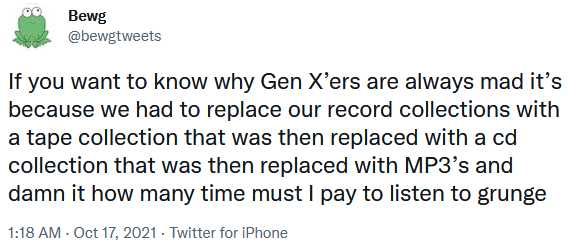
In the Summer of 1995 I bought the CD single of the (still excellent!) Set You Free by N-Trance.2 I’d heard about this new-fangled “MP3” audio format, so soon afterwards I decided to rip a copy of the song to my PC.
I was using a 66MHz 486SX CPU, and without an embedded FPU I didn’t
quite have the spare processing power to rip-and-encode in a single pass.3
So instead I first ripped to an uncompressed PCM .wav file and then performed the encoding: the former step
was done almost in real-time (I listened to the track as it ripped!), about 7 minutes. The latter step took about 20 minutes.
So… about half an hour in total, to rip a single song.
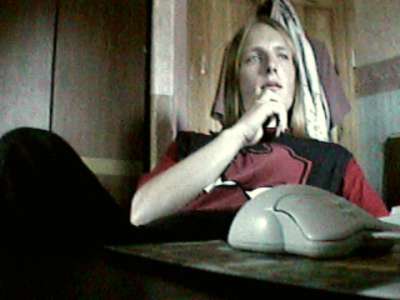
Creating a (what would now be considered an apalling) 32kHz mono-channel file, this meant that I briefly stored both a 27MB wave file and the final ~4MB MP3 file. 31MB might not sound huge, but I only had a total of 145MB of hard drive space at the time, so 31MB consumed over a fifth of my entire fixed storage! Even after deleting the intermediary wave file I was left with a single song consuming around 3% of my space, which is mind-boggling to think about in hindsight.
But it felt like magic. I called my friend Gary to tell him about it. “This is going to be massive!” I said. At the time, I meant for techy people: I could imagine a future in which, with more hard drive space, I’d keep all my music this way… or else bundle entire artists onto writable CDs in this new format, making albums obsolete. I never considered that over the coming decade or so the format would enter the public consciousness, let alone that it’d take off like it did.
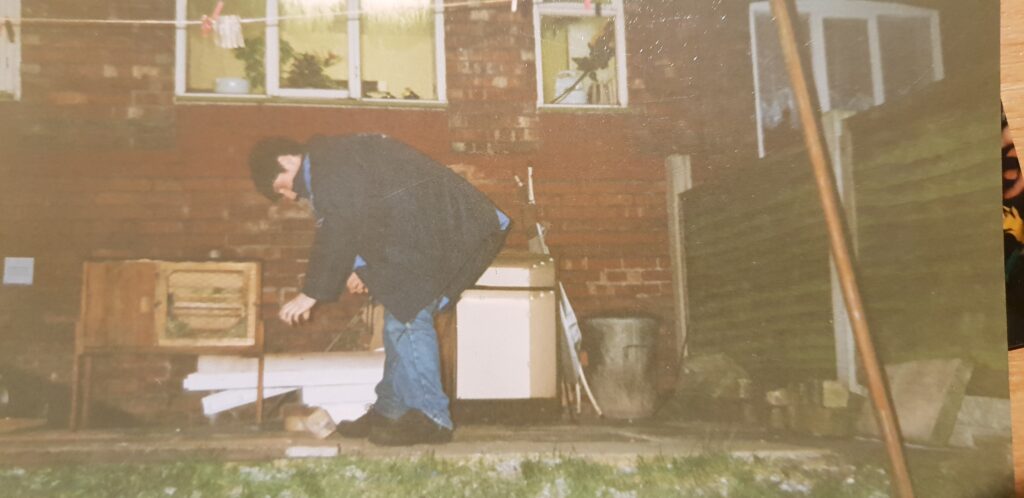
The MP3 file I produced had a fault. Most of the way through the encoding process, I got bored and ran another program, and this must’ve interfered with the stream because there was an audible “blip” noise about 30 seconds from the end of the track. You’d have to be listening carefully to hear it, or else know what you were looking for, but it was there. I didn’t want to go through the whole process again, so I left it.
But that artefact uniquely identified that copy of what was, in the end, a popular song to have in your digital music collection. As the years went by and I traded MP3 files in bulk at LAN parties or on CD-Rs or, on at least one ocassion, on an Iomega Zip disk (remember those?), I’d ocassionally see
N-Trance - (Only Love Can) Set You Free.mp34 being passed around and play it, to see if it was “my”
copy.
Sometimes the ID3 tags had been changed because for example the previous owner had decided it deserved to be considered Genre: Dance instead of Genre: Trance5. But I could still identify that file because
of the audio fingerprint, distinct to the first MP3 I ever created.
I still had that file when I went to university (where it occupied a smaller proportion of my hard drive space) and hearing that distinctive “blip” would remind me about the ordeal that was involved in its creation. I don’t have it any more, but perhaps somebody else still does.
1 I might never have told this story on my blog, but eagle-eyed readers may remember that I’ve certainly hinted at it before now.
2 Rewatching that music video, I’m struck by a recollection of how crazy popular crossfades were on 1990s dance music videos. More than just a transition, I’m pretty sure that most of the frames of that video are mid-crossfade: it feels like I’m watching Kelly Llorenna hanging out of a sunroof but I accidentally left one of my eyeballs in a smoky nightclub and can still see out of it as well.
3 I initially tried to convert directly from red book format to an MP3 file, but the encoding process was too slow and the CD drive’s buffer filled up and didn’t get drained by the processor, which was still presumably bogged down with framing or fourier-transforming earlier parts of the track. The CD drive reasonably assumed that it wasn’t actually being used and spun-down the drive motor, and this caused it to lose its place in the track, killing the whole process and leaving me with about a 40 second recording.
4 Yes, that filename isn’t quite the correct title. I was wrong.
5 No, it’s clearly trance. They were wrong.
I got lost on the Web this week, but it was harder than I’d have liked.

There was a discussion this week in the Abnib WhatsApp group about whether a particular illustration of a farm was full of phallic imagery (it was). This left me wondering if anybody had ever tried to identify the most-priapic buildings in the world. Of course towers often look at least a little bit like their architects were compensating for something, but some – like the Ypsilanti Water Tower in Michigan pictured above – go further than others.
I quickly found the Wikipedia article for the Most Phallic Building Contest in 2003, so that was my jumping-off point. It’s easy enough to get lost on Wikipedia alone, but sometimes you feel the need for a primary source. I was delighted to discover that the web pages for the Most Phallic Building Contest are still online 18 years after the competition ended!
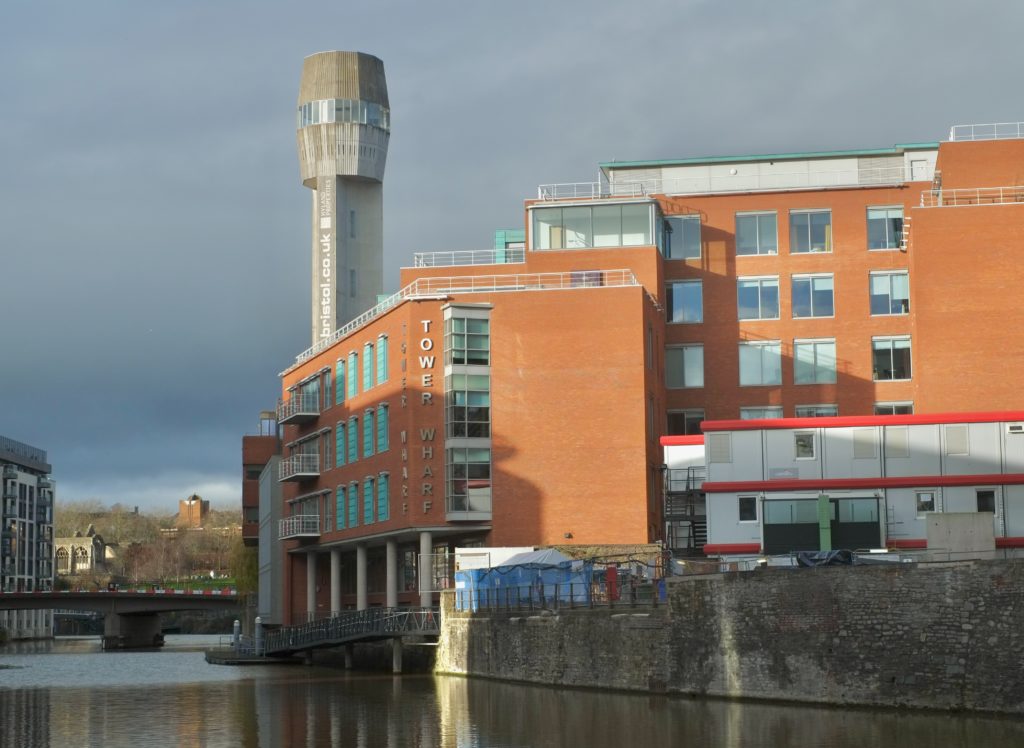
Link rot is a serious problem on the Web, to such an extent that it’s pleasing when it isn’t present. The other year, for example, I revisited a post I wrote in 2004 and was pleased to find that a linked 2003 article by Nicholas ‘Aquarion’ Avenell is still alive at its original address! Contrast Jonathan Ames, the author/columnist/screenwriter who created the Most Phallic Building Contest until as late as 2011 before eventually letting his site and blog lapse and fall off the Internet. It takes effort to keep Web content alive, but it’s worth more effort than it’s sometimes given.
Anyway: a shot tower in Bristol – a part of the UK with a long history of leadworking – was among the latecomer entrants to the competition, and seeing this curious building reminded me about something I’d read, once, about the manufacture of lead shot. The idea (invented in Bristol by a plumber called William Watts) is that you pour molten lead through a sieve at the top of a tower, let surface tension pull it into spherical drops as it falls, and eventually catch it in a cold water bath to finish solidifying it. I’d seen an animation of the process, but I’d never seen a video of it, so I went about finding one.
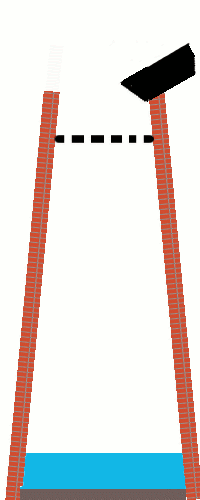
British Pathé‘s YouTube Channel provided me with this 1950 film, and if you follow only one hyperlink from this article, let it be this one! It’s a well-shot (pun intended, but there’s a worse pun in the video!), and while I needed to translate all of the references to “hundredweights” and “Fahrenheit” to measurements that I can actually understand, it’s thoroughly informative.
But there’s a problem with that video: it’s been badly cut from whatever reel it was originally found on, and from about 1 minute and 38 seconds in it switches to what is clearly a very different film! A mother is seen shepherding her young daughter off to bed, and a voiceover says:
Bedtime has a habit of coming round regularly every night. But for all good parents responsibility doesn’t end there. It’s just the beginning of an evening vigil, ears attuned to cries and moans and things that go bump in the night. But there’s no reason why those ears shouldn’t be your neighbours ears, on occasion.
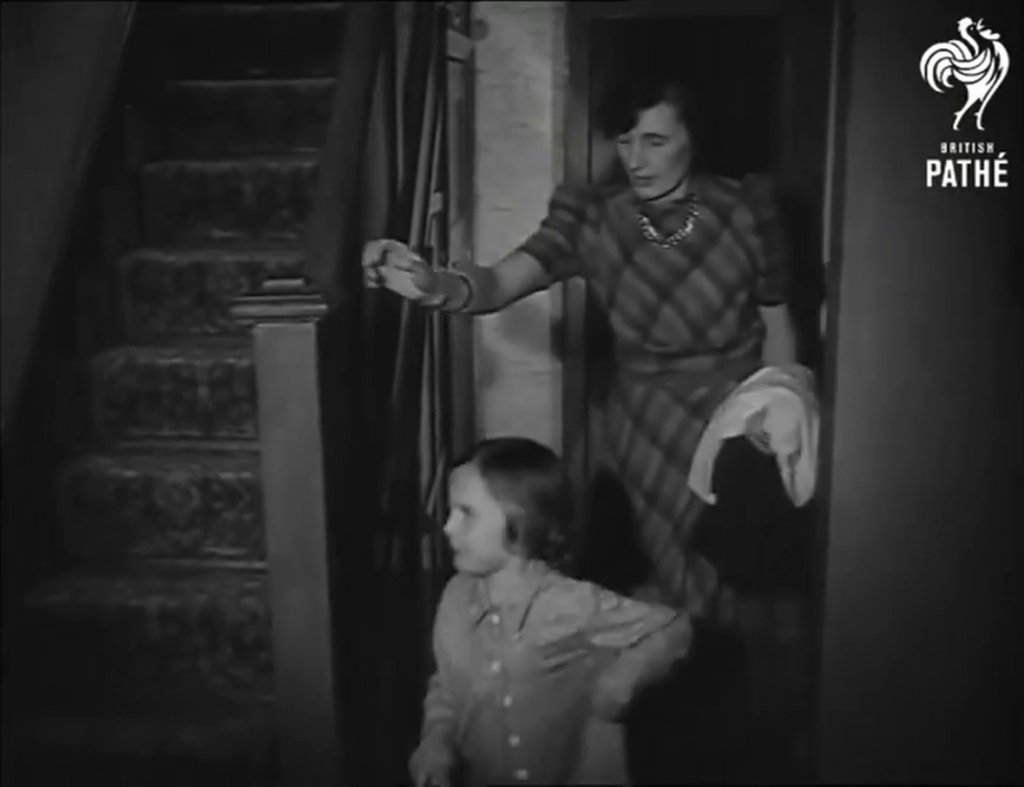
Now my interest’s piqued. What was this short film going to be about, and where could I find it? There’s no obvious link; YouTube doesn’t even make it easy to find the video uploaded “next” by a given channel. I manipulated some search filters on British Pathé’s site until I eventually hit upon the right combination of magic words and found a clip called Radio Baby Sitter. It starts off exactly where the misplaced prior clip cut out, and tells the story of “Mr. and Mrs. David Hurst, Green Lane, Coventry”, who put a microphone by their daughter’s bed and ran a wire through the wall to their neighbours’ radio’s speaker so they can babysit without coming over for the whole evening.
It’s a baby monitor, although not strictly a radio one as the title implies (it uses a signal wire!), nor is it groundbreakingly innovative: the first baby monitor predates it by over a decade, and it actually did use radiowaves! Still, it’s a fun watch, complete with its contemporary fashion, technology, and social structures. Here’s the full thing, re-merged for your convenience:
Wait, what was I trying to do when I started, again? What was I even talking about…
It used to be easier than this to get lost on the Web, and sometimes I miss that.
Obviously if you go back far enough this is true. Back when search engines were much weaker and Internet content was much less homogeneous and more distributed, we used to engage in this kind of meandering walk all the time: we called it “surfing” the Web. Second-generation Web browsers even had names, pretty often, evocative of this kind of experience: Mosaic, WebExplorer, Navigator, Internet Explorer, IBrowse. As people started to engage in the noble pursuit of creating content for the Web they cross-linked their sources, their friends, their affiliations (remember webrings? here’s a reminder; they’re not quite as dead as you think!), your favourite sites etc. You’d follow links to other pages, then follow their links to others still, and so on in that fashion. If you went round the circles enough times you’d start seeing all those invariably-blue hyperlinks turn purple and know you’d found your way home.
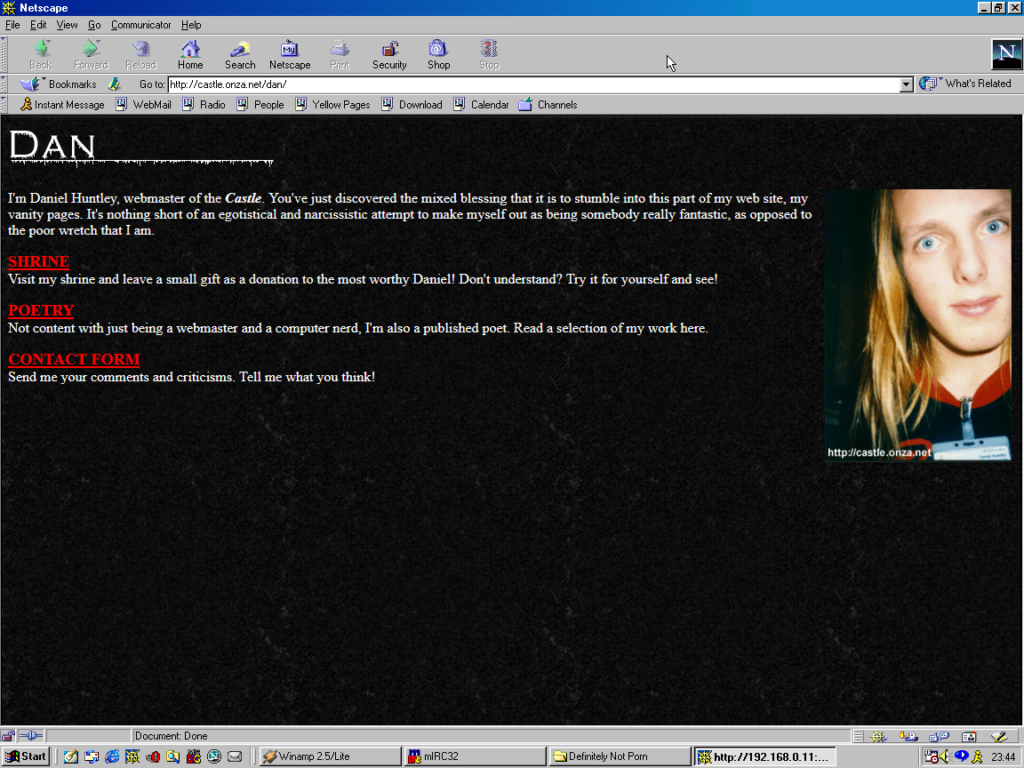
But even after that era, as search engines started to become a reliable and powerful way to navigate the wealth of content on the growing Web, links still dominated our exploration. Following a link from a resource that was linked to by somebody you know carried the weight of a “web of trust”, and you’d quickly come to learn whose links were consistently valuable and on what subjects. They also provided a sense of community and interconnectivity that paralleled the organic, chaotic networks of acquaintances people form out in the real world.
In recent times, that interpersonal connectivity has, for many, been filled by social networks (let’s ignore their failings in this regard for now). But linking to resources “outside” of the big social media silos is hard. These advertisement-funded services work hard to discourage or monetise activity that takes you off their platform, even at the expense of their users. Instagram limits the number of external links by profile; many social networks push for resharing of summaries of content or embedding content from other sources, discouraging engagement with the wider Web, Facebook and Twitter both run external links through a linkwrapper (which sometimes breaks); most large social networks make linking to the profiles of other users of the same social network much easier than to users anywhere else; and so on.
The net result is that Internet users use fewer different websites today than they did 20 years ago, and spend most of their “Web” time in app versions of websites (which often provide a better experience only because site owners strategically make it so to increase their lock-in and data harvesting potential). Truly exploring the Web now requires extra effort, like exercising an underused muscle. And if you begin and end your Web experience on just one to three services, that just feels kind of… sad, to me. Wasted potential.

It sounds like I’m being nostalgic for a less-sophisticated time on the Web (that would certainly be in character!). A time before we’d fully-refined the technology that would come to connect us in an instant to the answers we wanted. But that’s not exactly what I’m pining for. Instead, what I miss is something we lost along the way, on that journey: a Web that was more fun-and-weird, more interpersonal, more diverse. More Geocities, less Facebook; there’s a surprising thing to find myself saying.
Somewhere along the way, we ended up with the Web we asked for, but it wasn’t the Web we wanted.
As I mentioned last year, for several years I’ve collected pretty complete historic location data from GPSr devices I carry with me everywhere, which I collate in a personal μlogger server.
Going back further, I’ve got somewhat-spotty data going back a decade, thanks mostly to the fact that I didn’t get around to opting-out of Google’s location tracking until only a few years ago (this data is now also housed in μlogger). More-recently, I now also get tracklogs from my smartwatch, so I’m managing to collate more personal location data than ever before.
Inspired perhaps at least a little by Aaron Parecki, I thought I’d try to do something cool with it.
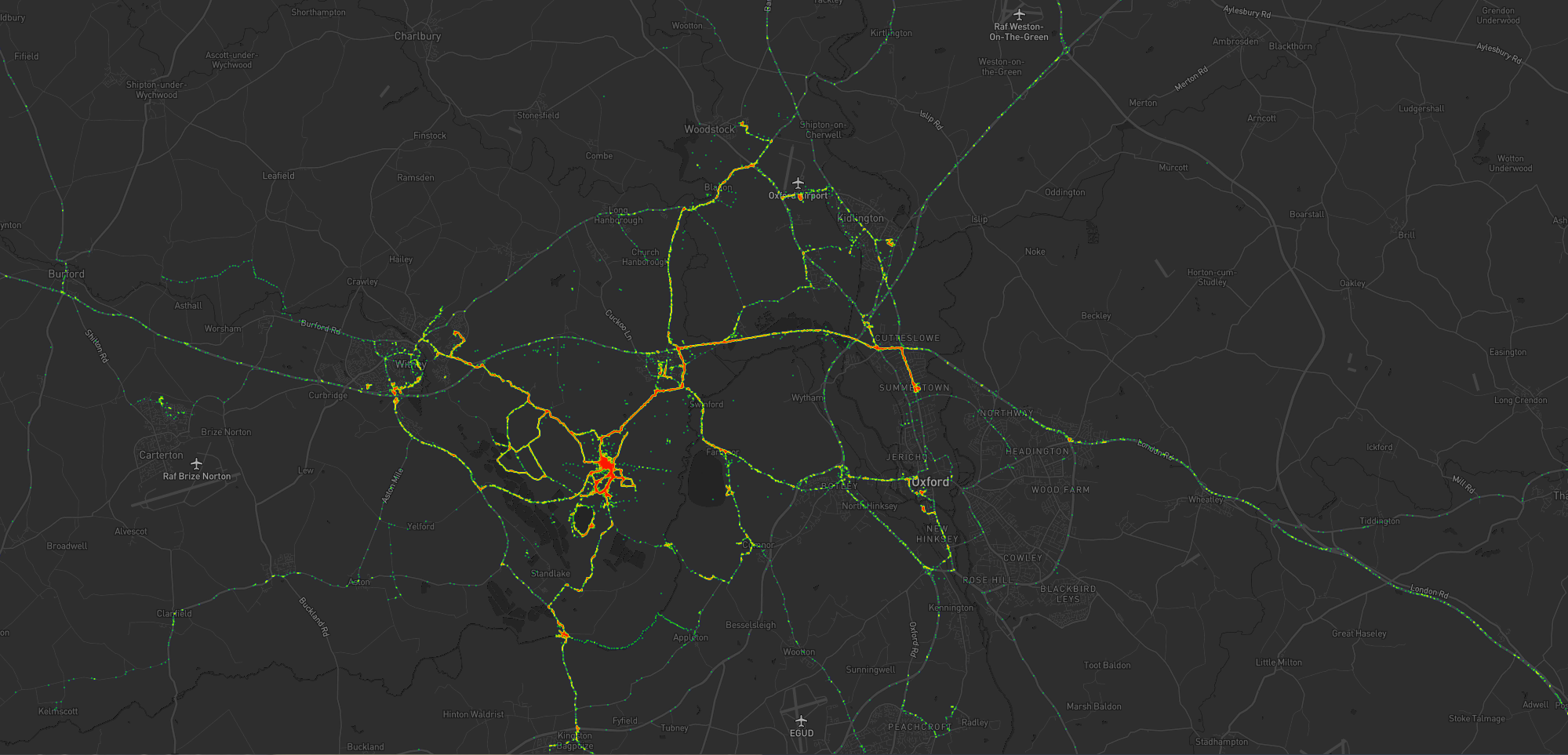
What you’re looking at is a heatmap showing my location over the last year or so since I moved to The Green. Between the pandemic and switching a few months prior to a job that I do almost-entirely at home there’s not a lot of travel showing, but there’s some. Points of interest include:
Let’s go back to the 7 years prior, when I lived in Kidlington. This paints a different picture:
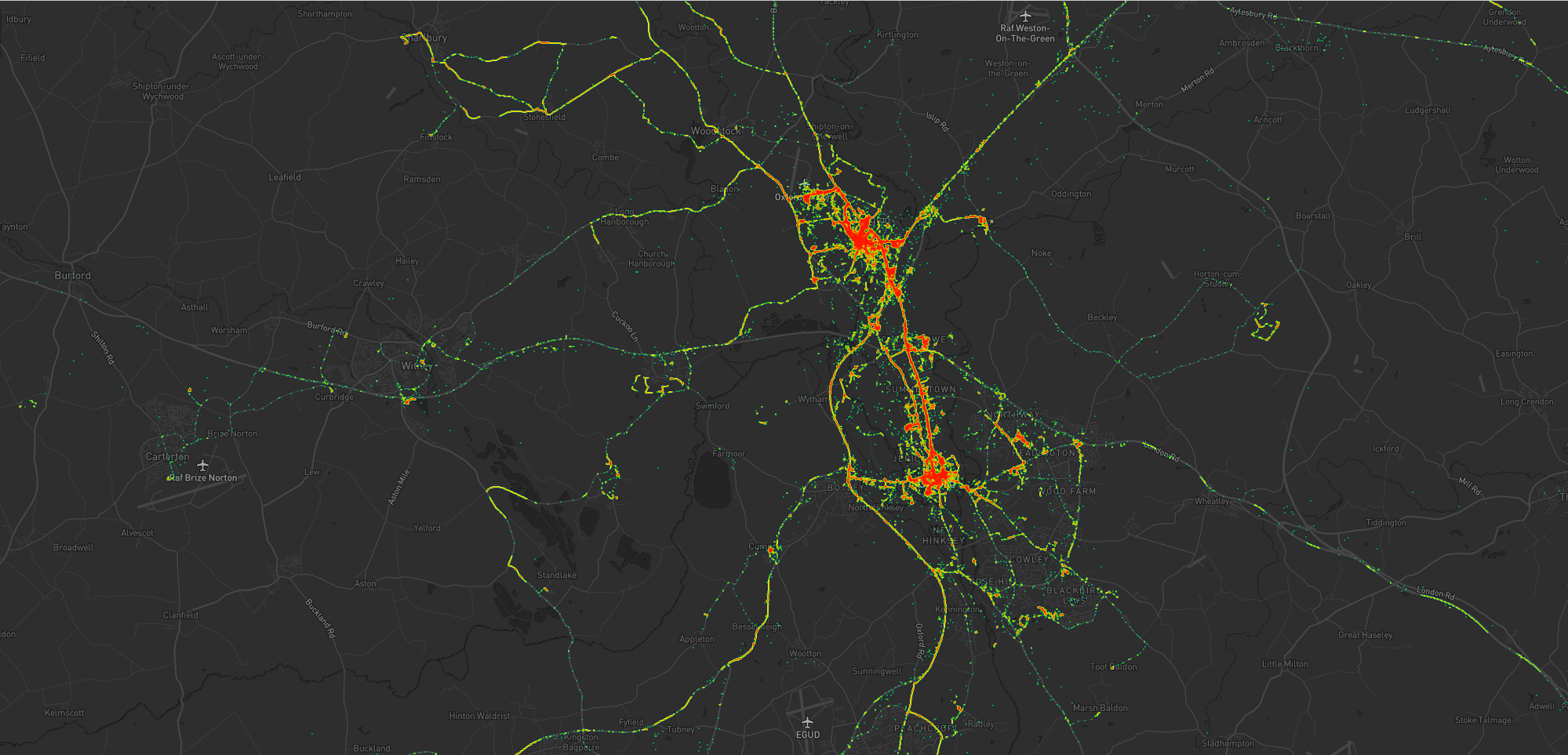
This heatmap highlights some of the ways in which my life was quite different. For example:
Let’s go back further:
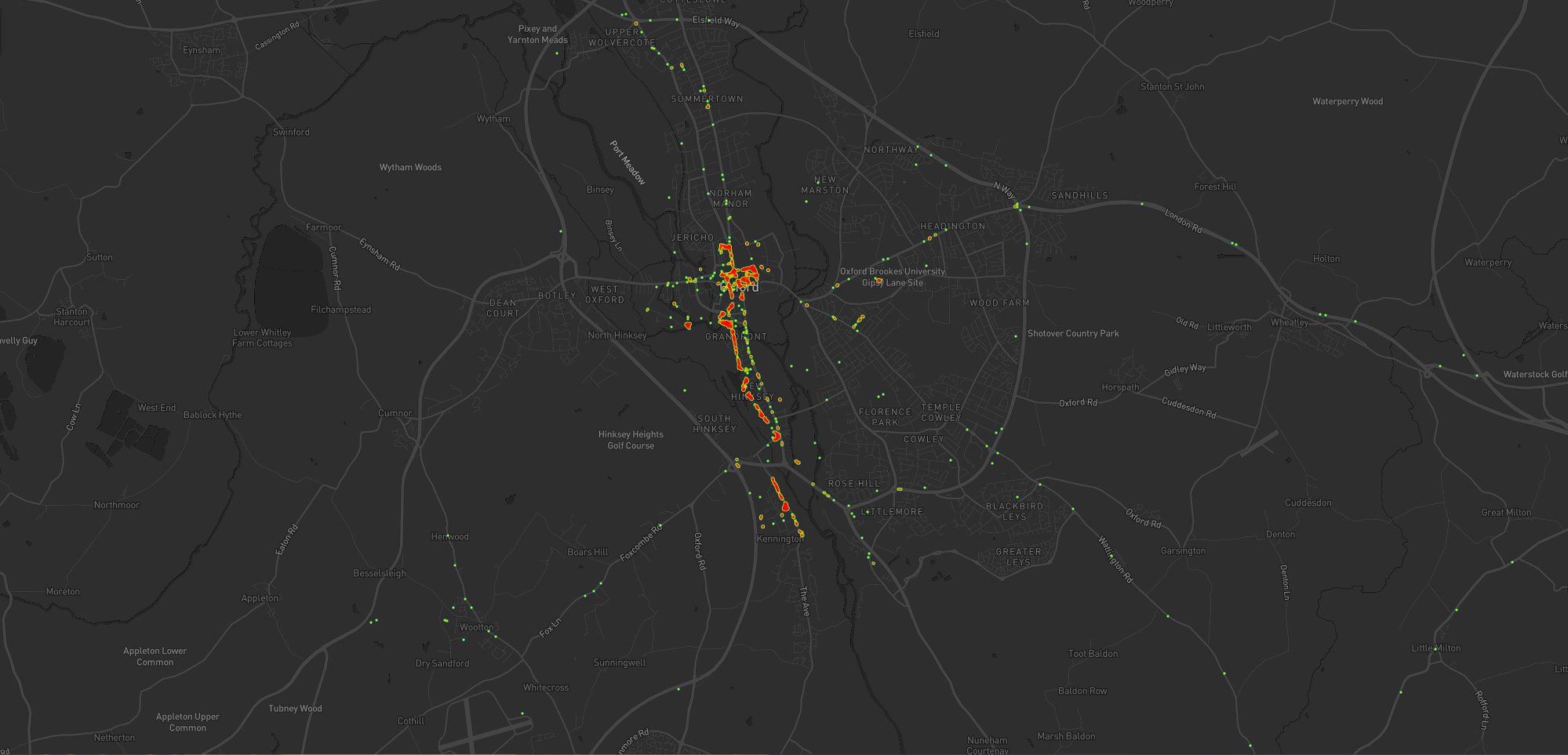
Before 2011, and before we bought our first house, I spent a couple of years living in Kennington, to the South of Oxford. Looking at this heatmap, you’ll see:
I really love maps, and I love the fact that these heatmaps are capable of painting a picture of me and what my life was like in each of these three distinct chapters of my life over the last decade. I also really love that I’m able to collect and use all of the personal data that makes this possible, because it’s also proven useful in answering questions like “How many times did I visit Preston in 2012?”, “Where was this photo taken?”, or “What was the name of that place we had lunch when we got lost during our holiday in Devon?”.
There’s so much value in personal geodata (that’s why unscrupulous companies will try so hard to steal it from you!), but sometimes all you want to do is use it to draw pretty heatmaps. And that’s cool, too.
I have a μlogger instance with the relevant positional data in. I’ve automated my process, but the essence of it if you’d like to try it yourself is as follows:
First, write some SQL to extract all of the position data you need. I round off the latitude and longitude to 5 decimal places to help “cluster” dots for frequency-summing, and I raise the frequency to the power of 3 to help make a clear gradient in my heatmap by making hotspots exponentially-brighter the more popular they are:
SELECT ROUND(latitude, 5) lat, ROUND(longitude, 5) lng, POWER(COUNT(*), 3) `count` FROM positions WHERE `time` BETWEEN '2020-06-22' AND '2021-08-22' GROUP BY ROUND(latitude, 5), ROUND(longitude, 5)
This data needs converting to JSON. I was using Ruby’s mysql2 gem to
fetch the data, so I only needed a .to_json call to do the conversion – like this:
db = Mysql2::Client.new(host: ENV['DB_HOST'], username: ENV['DB_USERNAME'], password: ENV['DB_PASSWORD'], database: ENV['DB_DATABASE']) db.query(sql).to_a.to_json
Approximately following this guide and leveraging my Mapbox
subscription for the base map, I then just needed to include leaflet.js, heatmap.js, and leaflet-heatmap.js before writing some JavaScript code
like this:
body.innerHTML = '<div id="map"></div>'; let map = L.map('map').setView([51.76, -1.40], 10); // add the base layer to the map L.tileLayer('https://api.mapbox.com/styles/v1/{id}/tiles/{z}/{x}/{y}?access_token={accessToken}', { maxZoom: 18, id: 'itsdanq/ckslkmiid8q7j17ocziio7t46', // this is the style I defined for my map, using Mapbox tileSize: 512, zoomOffset: -1, accessToken: '...' // put your access token here if you need one! }).addTo(map); // fetch the heatmap JSON and render the heatmap fetch('heat.json').then(r=>r.json()).then(json=>{ let heatmapLayer = new HeatmapOverlay({ "radius": parseFloat(document.querySelector('#radius').value), "scaleRadius": true, "useLocalExtrema": true, }); heatmapLayer.setData({ data: json }); heatmapLayer.addTo(map); });
That’s basically all there is to it!
I recreated a 16-year old interactive ad. Experience it here. Get the source code here. Or keep reading for the full story.
Back in 2005 I reblogged a Flash-based interactive advert I’d discovered via del.icio,us. And if that sentence wasn’t early-naughties enough for you, buckle up…
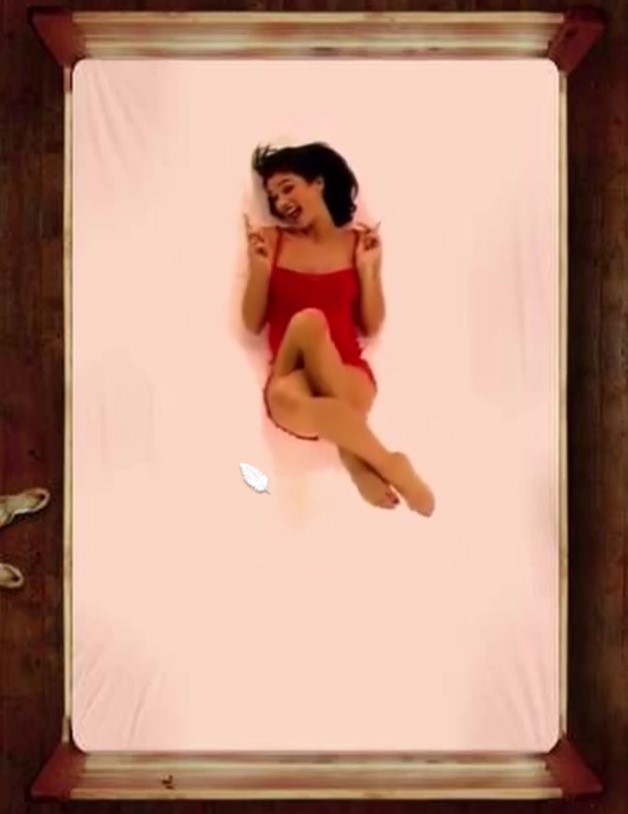
At the end of 2004, Unilever brand Axe (Lynx here in the UK) continued their strategy of marketing their deodorant as magically transforming young men into hyper-attractive sex gods. This is, of course, an endless battle, pitting increasingly sexually-charged advertisements against the fundamental experience of their product, which smells distinctly like locker rooms and school discos. To launch 2005’s new fragrance Feather, they teamed up with London-based design agency Dare Digital to create a game at domain AxeFeather.com (long since occupied by domain squatters).
In the game, the player’s mouse pointer becomes a feather which they can use to tickle an attractive young woman lying on a bed. The woman’s movements – which vary based on where she’s tickled – have been captured in digital video. This was aggressively compressed using the then-new H.263-ish Sorensen Spark codec to make a download just-about small enough to be tolerable for people still on dial-up Internet access (which was still almost as popular as broadband). The ad became a viral hit. I can’t tell you whether it paid for itself in sales, but it must have paid for itself in brand awareness: on Valentines Day 2005 it felt like it was all the Internet wanted to talk about.

I suspect its success also did wonders for the career of its creative consultant Olivier Rabenschlag, who left Dare a few years later, hopped around Silicon Valley for a bit, then landed himself a job as Head of Creative (now Chief Creative Officer) with Google. Kudos.
I told you about the site 16 years ago: why am I telling you again? Because this site, which made headlines at the time, is gone.
And not just a little bit gone, like a television ad no longer broadcast but which might still exist on YouTube somewhere (and here it is – you’re welcome for the earworm). The website went down in 2009, and because it was implemented in Flash the content was locked away in a compiled, proprietary format, which has ceased to be meaningfully usable on the modern web.

The ad was pioneering. Flash had only recently gained video support (this would be used the following year for the first version of YouTube), and it had so far been used mostly for non-interactive linear video. This ad was groundbreaking… but now it’s disappeared like so much other Flash work. And for all that Flash might have been bad for the web, it’s an important part of our digital history [recommended reading].
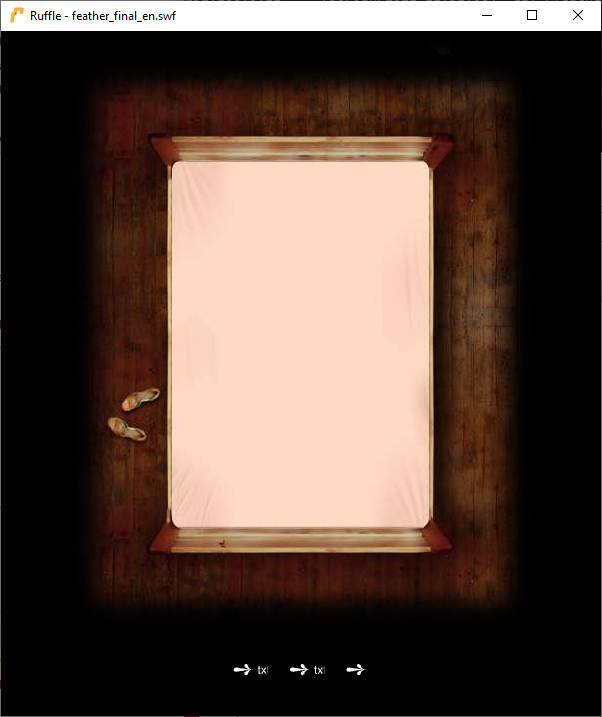
So on a whim… I decided to see if I could recreate the ad.
Call it lockdown fever if you like, because it’s certainly not the work of a sane mind to attempt to resurrect a 16-year-old Internet advertisement. But that’s what I did.
My plan: to reverse-engineer the digital assets (video, audio, cursor etc.) out of the original Flash file, and use them to construct a moderately-faithful recreation of the ad, suitable for use on the modern web. My version must:
.flv support to mobile devices…
Let’s get started.
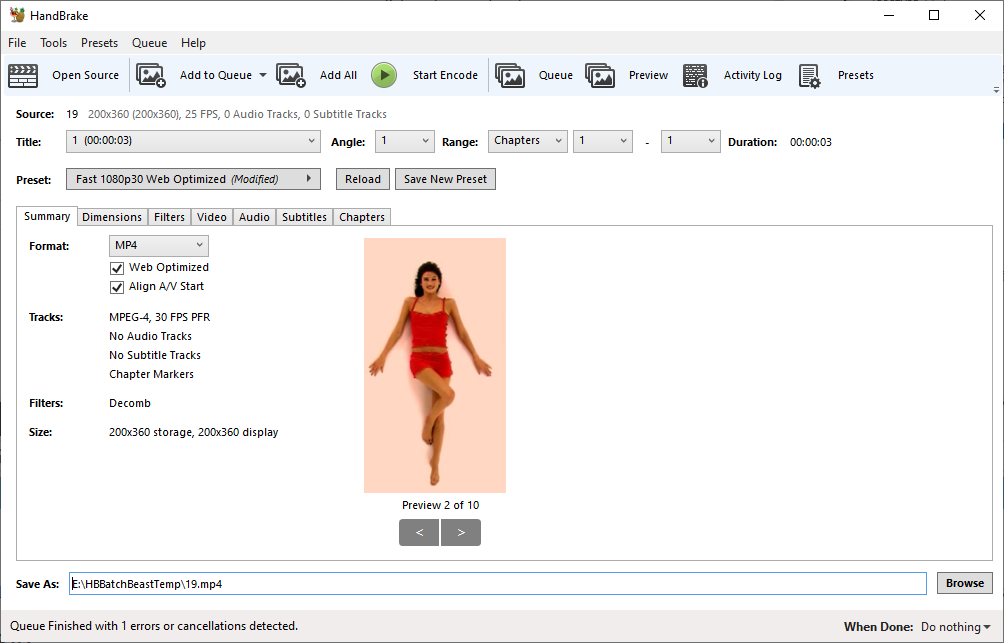
I grabbed the compiled .swf file from archive.org and ran it through
SWFExtract and an online decompiler: neither was individually able to extract
all of the assets, but together they gave me a full set. I ran the .flv files through Handbrake to get myself a set of
.mp4 files instead.

Seeing that the extracted video files were clearly designed to be carefully-positioned on a static background, and not all in the exact same position, I decided to make my job easier by combining them all together, and including the background layer (the picture of the bed) as a single video. Integrating the background with the subject meant that I was able to use video editing software to tweak the position, which I imagined would be much easier than doing so in code. Combining all of the video clips into a single file provides compression benefits as well as making it easier to encourage a browser to precache the entire video to begin with.

The longest clip was a little over 6 seconds long, so I split my timeline into blocks of 7 seconds, padding each clip with a freeze-frame of its final image to make each exactly 7 seconds long. This meant that calculating the position in the finished video to which I wanted to jump was as simply as multiplying the (0-indexed) clip number by 7 and seeking to that position. The additional “frozen” frames acted as a safety buffer in case my JavaScript code was delayed by a few milliseconds in jumping to the “next” block.

An additional challenge was that in the original binary, the audio files were stored separately from the video clips… and slightly longer than them! A little experimentation revealed that the ends of each clip lined up, presumably something to do with how Flash preloads and synchronises media streams. Luckily for me, the audio clips were numbered such that they mostly mapped to the order in which the videos appeared.
Once I had a video file suitable for use on the web (you can watch the entire clip here, if you really want to), it was time to write some code.

The theory was simple: web page, video, loop the first seven seconds until you click on it, then animate the cursor (a feather) and jump to another seven-second block before jumping back or, in some cases, on to a completely new seven second block. Simple!
Of course, any serious web development is always a little more complex than you first anticipate.

.swf 34 distinct animated clips, which I numbered 0 through 33. 6 and 30 appeared to be duplicates of others. 0 and 33 are each two “idling” states
from which interaction can lead to other states. Note that my interpretation of the order and relationship of animation sequences differs from the original.
For example: nowadays, putting a video on a web page is as easy as a <video> tag. But, in an effort to prevent background web pages from annoying you with unexpected
audio, modern browsers won’t let a video play sound unless user interaction is the reason that the video starts playing (or unmutes, if it was playing-but-muted to
begin with). Broadly-speaking, that means that a definitive user action like a “click” event has to be in the call stack when your code makes the video play/unmute.
But changing the .currentTime of a video to force it into a loop: that’s fine! So I set the video to autoplay muted on page load, with a script to make it loop
within its first seven-second block. The actress doesn’t make any sound in block 0 (position A) anyway; so I can unmute the video when the user interacts with a hotspot.
For best performance, I used window.requestAnimationFrame to synchronise my non-interactive events (video loops, virtual cursor repositioning). This posed a slight problem
in that animationframes wouldn’t be triggered if the tab was moved to the background: the video would play through each seven-second block and into the next! Fortunately the
visibilitychange event came to the rescue and I was able to pause the video when it wasn’t being actively watched.
I originally hoped to use the cursor: CSS directive to make the “feather” cursor, but there’d be no nice way to
animate it. Comet Cursor may have been able to use animated GIFs
as cursors back in 1997 (when it wasn’t busy selling all your personal information to advertisers, back when that kind of thing used to attract widespread controversy), but modern
browsers don’t… presumably because it would be super annoying. They also don’t all respect cursor: none, so I used the old trick of using cursor: url(null.png),
none (where null.png is an almost-entirely transparent 1×1 pixel image) to hide the original cursor, then position an image dynamically. I
usegetBoundingClientRect() to allow the video to resize dynamically in CSS and convert coordinates on it represented
as percentages into actual pixel values and vice-versa: this allows it to react responsively to any screen size without breakpoints or excessive code.
Once I’d gone that far I was able to drop the GIF idea entirely and used a CSS animation for the “tickling” motion.
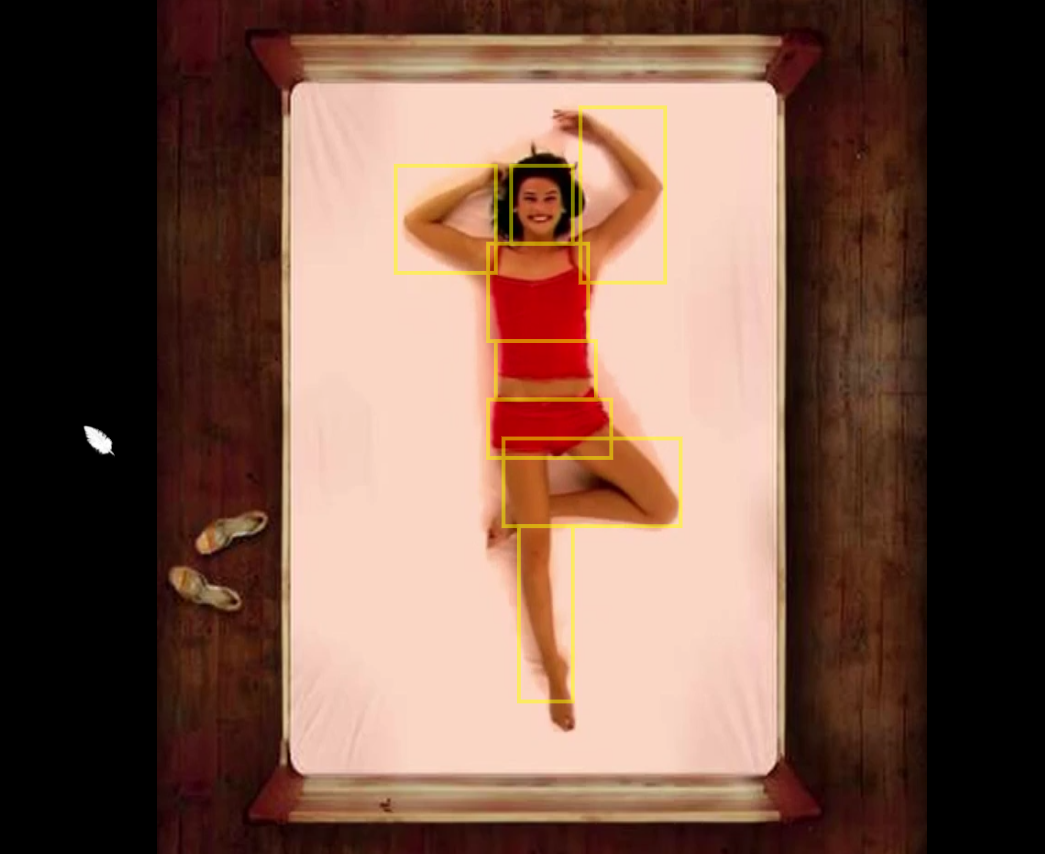
I added a transparent <canvas> element on top of the <video> on which the hit areas are dynamically drawn to help me test the “hotspots” and tweak
their position. I briefly considered implementing a visual tool to help me draw the hotspots, but figured it wasn’t quite worth the time it would take.
As I implemented more and more of the game, I remembered one feature from the original that I’d missed: the “blowaway”. If you trigger block 31 – a result of tickling the woman’s nose – she’ll blow your cursor off the screen. It’s particularly fun because it subverts the player’s expectations of their user interface: once you’ve got past the surprise of your cursor being a feather, you quickly settle in to it moving like a regular cursor… but then control’s stolen from you and the cursor vanishes! (Well I thought it was cool… 16 years ago.)

So yeah: that was my project this weekend.
I can’t even begin to explain why anybody would do this. But I did it. If you haven’t already: go have a play. And if you’re interested in how it works, the source code’s free for you to explore.
This is a repost promoting content originally published elsewhere. See more things Dan's reposted.
Remember Winamp (especially Winamp 1/2, back when it was awesome)? Remember Winamp skins?
Webamp does.
This is not only a gallery of skins, they’re all interactive! Click into one and try it out. It really whips the llama’s ass.
This is a repost promoting content originally published elsewhere. See more things Dan's reposted.
Back in February my friend Katie shared with me an already four-year-old piece of interactive fiction, Bus Station: Unbound, that I’d somehow managed to miss the first time around. In the five months since then I’ve periodically revisited and played through it and finally gotten around to writing a review:
All of the haunting majesty of its subject, and a must-read-thrice plot
Perhaps it helps to be as intimately familiar with Preston Bus Station – in many ways, the subject of the piece – as the protagonist. This work lovingly and faithfully depicts the space and the architecture in a way that’s hauntingly familiar to anybody who knows it personally: right down to the shape of the rubberised tiles near the phone booths, the forbidding shadows of the underpass, and the buildings that can be surveyed from its roof.
But even without such a deep recognition of the space… which, ultimately, soon comes to diverge from reality and take on a different – darker, otherworldly – feel… there’s a magic to the writing of this story. The reader is teased with just enough backstory to provide a compelling narrative without breaking the first-person illusion. No matter how many times you play (and I’ve played quite a few!), you’ll be left with a hole of unanswered questions, and you’ll need to be comfortable with that to get the most out of the story, but that in itself is an important part of the adventure. This is a story of a young person who doesn’t – who can’t – know everything that they need to bring them comfort in the (literally and figuratively) cold and disquieting world that surrounds them, and it’s a world that’s presented with a touching and tragic beauty.
Through multiple playthroughs – or rewinds, which it took me a while to notice were an option! – you’ll find yourself teased with more and more of the story. There are a few frankly-unfair moments where an unsatisfactory ending comes with little or no warning, and a handful of places where it feels like your choices are insignificant to the story, but these are few and far between. Altogether this is among the better pieces of hypertext fiction I’ve enjoyed, and I’d recommend that you give it a try (even if you don’t share the love-hate relationship with Preston Bus Station that is so common among those who spent much of their youth sitting in it).
It’s no secret that I spent a significant proportion of my youth waiting for or changing buses at (the remarkable) Preston Bus Station, and that doubtless biases my enjoyment of this game by tingeing it with nostalgia. But I maintain that it’s a well-written piece of hypertext interactive fiction with a rich, developed world. You can play it starting from here, and you should. It looks like the story’s accompanying images died somewhere along the way, but you can flick through them all here and get a feel for the shadowy, brutalist, imposing place.
This is a repost promoting content originally published elsewhere. See more things Dan's reposted.
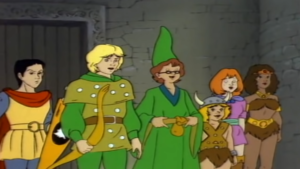 Remember that 80s TV show Dungeons & Dragons?
Remember that 80s TV show Dungeons & Dragons?
It turns out that Renault’s target customer base in Brazil do, too. Presumably it was a way bigger deal over there than it was here, because this new car ad feels like it could genuinely be a trailer for a live-action reboot of the series. And now I want to watch it.
(I do have some questions, though. Like: Diana was only 14 years old when she and her friends were transported to the Realm of Dungeons and Dragons… so when did she learn to drive? Am I supposed to believe that she just rolled a natural 20 on that driving check? And where does Sheila go when she turns invisible so that Bobby doesn’t end up sitting on her transparent-lap? And how does the car’s navigation computer work: are we to believe that there’s a GNSS network in the skies above the Realm? The Internet must know!)
tl;dr: TRRTL.COM is my reimplementation of a Logo on-screen turtle as a CoffeeScript-backed web application
For many children growing up in the 1970s and 1980s, their first exposure to computer programming may have come in the form of Logo, a general-purpose educational programming language best-known for its “turtle graphics” capabilities. By issuing commands to an on-screen – or, if they were really lucky, robotic – cursor known as a turtle, the student could draw lines and curves all over the screen (or in the case of robotic turtles: a large sheet of paper on the floor).
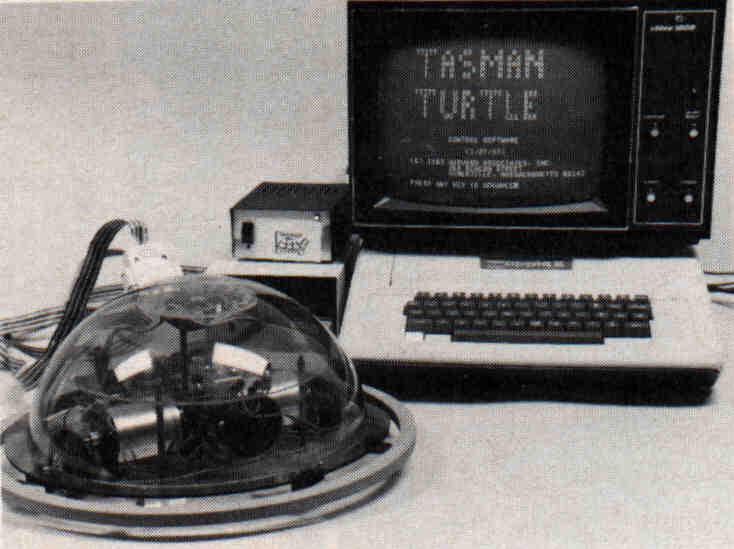
While our eldest and I were experimenting with programming (because, well…) a small robotic toy of hers, inspired by a book, it occurred to me that this was an experience that she might miss out on. That’s fine, of course: she doesn’t have to find the same joy in playing with Logo on an Amstrad CPC or a BBC Micro that I did… but I’d like her to be able to have the option. In fact, I figured, there’s probably a whole generation of folks who played with Logo in their childhood but haven’t really had the opportunity to use something as an adult that gives the same kind of satisfaction. And that’s the kind of thing I can fix.
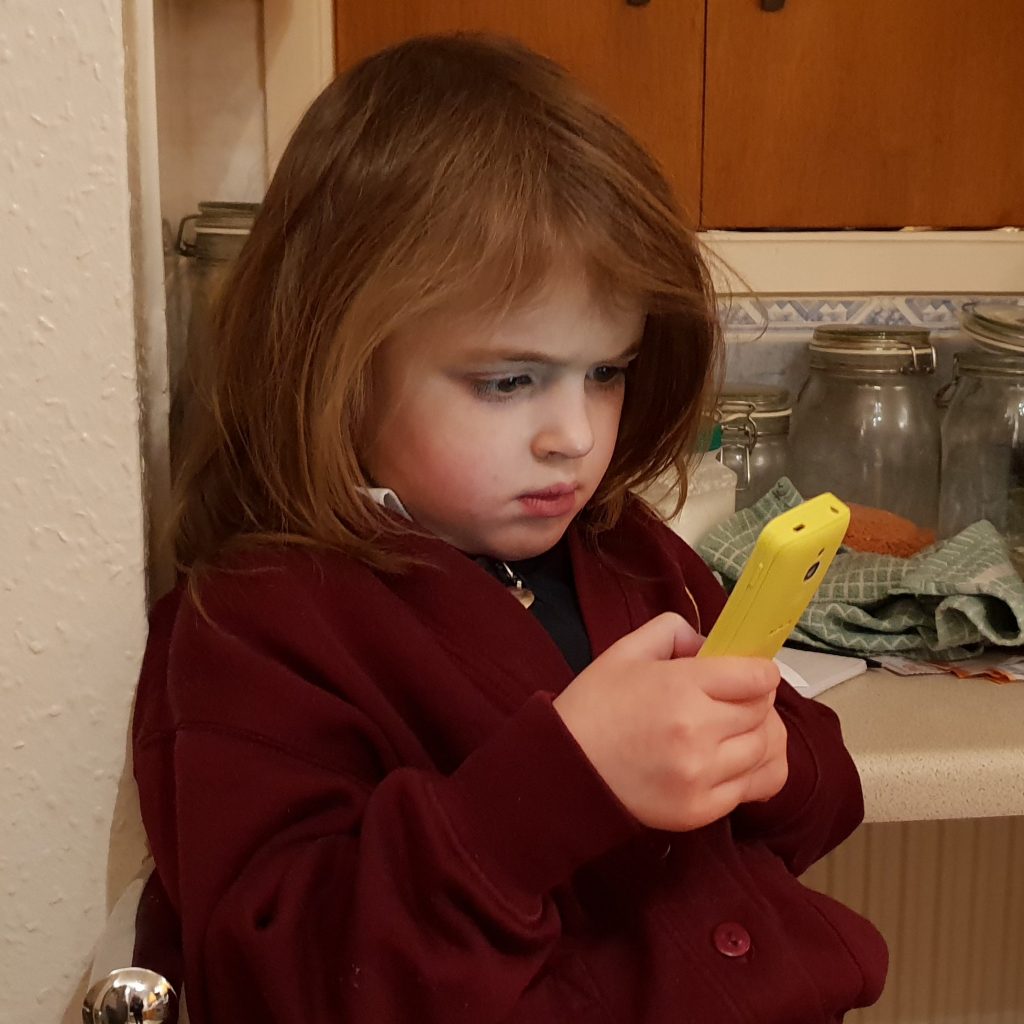
TRRTL.COM is my attempt to produce a modern, web-based (progressive, offline-first) re-imagining of Logo. It uses CoffeeScript as its base language because it provides all of the power of JavaScript but supports a syntax that’s more-similar to that of traditional Logo implementations (with e.g. optional semicolons and unparenthesised parameters).
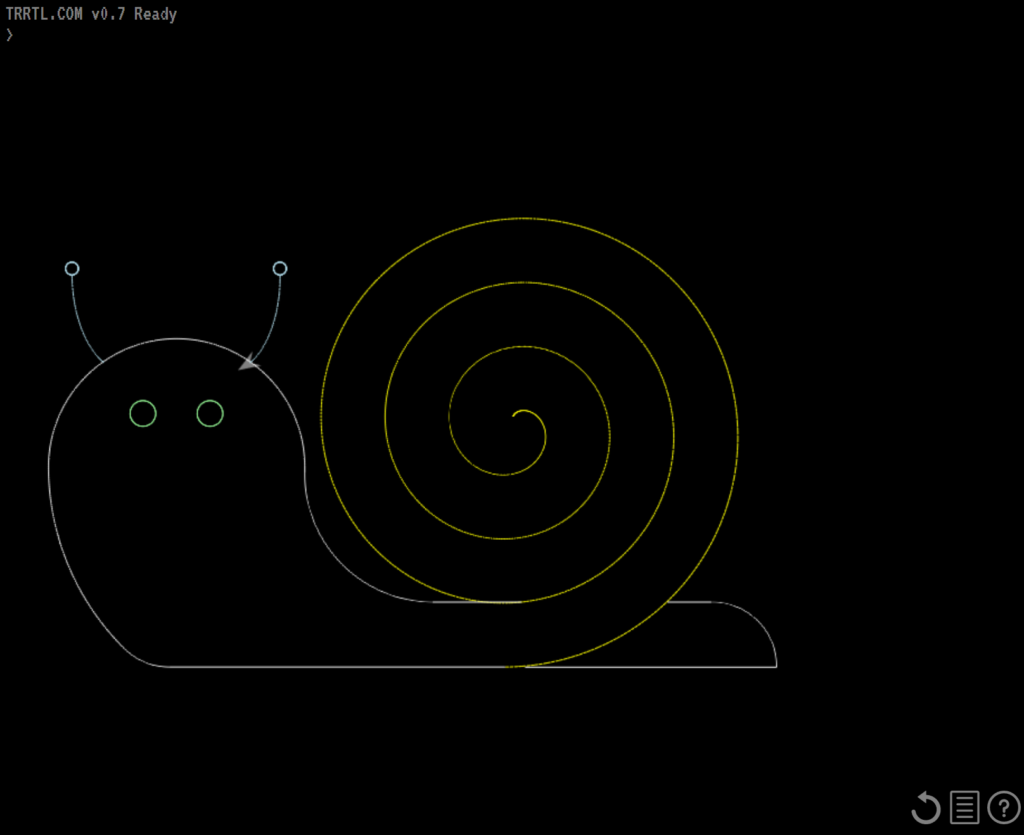
If you’ve not used Logo before, give it a go. Try typing simple commands like forward 100 (steps), right 90 (degrees), and so
on and you’ll find it’s a bit like an etch-a-sketch. Click the “help” icon in the corner for more commands (and shorter forms of them) as well as instructions on writing longer programs
and sharing your work with the world.
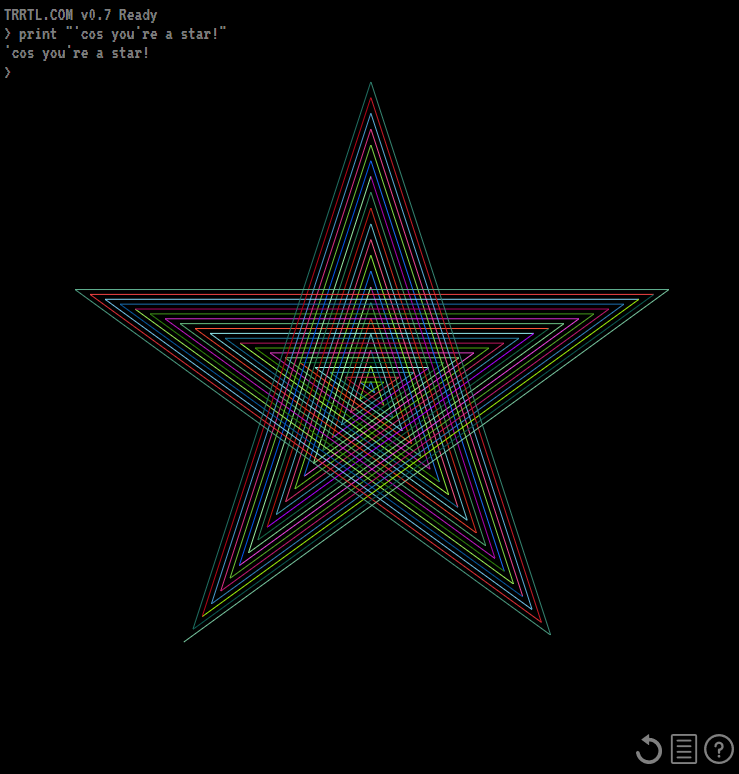
And of course the whole thing is open source in the most permissive way imaginable, so if you’re of an
inclination to do your own experiments with <canvas>, Progressive Web Apps, and the like, you’re welcome to borrow from me. Or if anybody wants to tag-team on making
a version that uses the Web Bluetooth API to talk to a robotic turtle or to use WebRTC to make LAN “multiplayer” turtle art, I’m totally game for that.
My volunteering and academic workload for the rest of this year is likely to reduce the amount of random/weird stuff I put online, so it might get boring here for a while. Hope this tides you over in the meantime.
Unless they happened to bump into each other at QParty, the first time Ruth and JTA met my school friend Gary was at my dad’s funeral. Gary had seen mention of the death in the local paper and came to the wake. About 30 seconds later, Gary and I were reminiscing, exchanging anecdotes about our misspent youths, when suddenly JTA blurted out: “Oh my God… you’re Sc… Sc-gary?”
Ever since then, my internal monologue has referred to Gary by the new nickname “Scgary”, but to understand why requires a little bit of history…
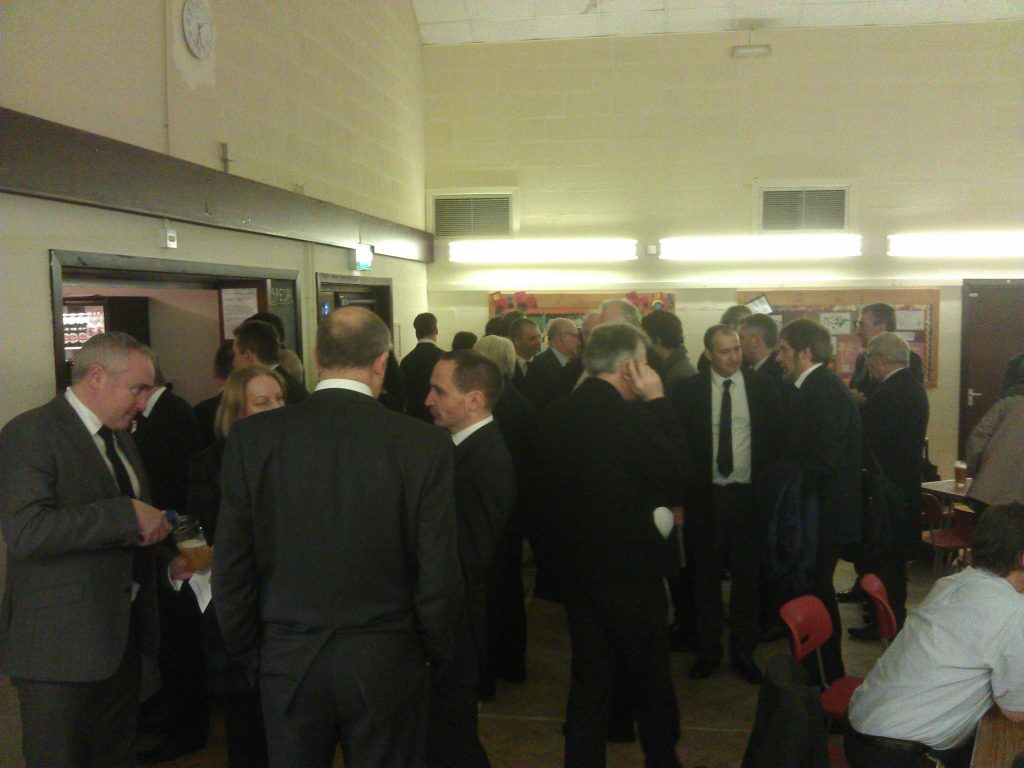
Despite having been close for over a decade, Gary and I drifted apart somewhat after I moved to Aberystwyth in 1999, especially as I became more and more deeply involved with volunteering at Aberystwyth Nightline and the resulting change in my social circle which soon was 90% comprised of fellow volunteers, (ultimately resulting in JTA’s “What, Everyone?” moment). We still kept in touch, but our once more-intense relationship – which started in a primary school playground! – was put on a backburner as we tackled the next big things in our lives.
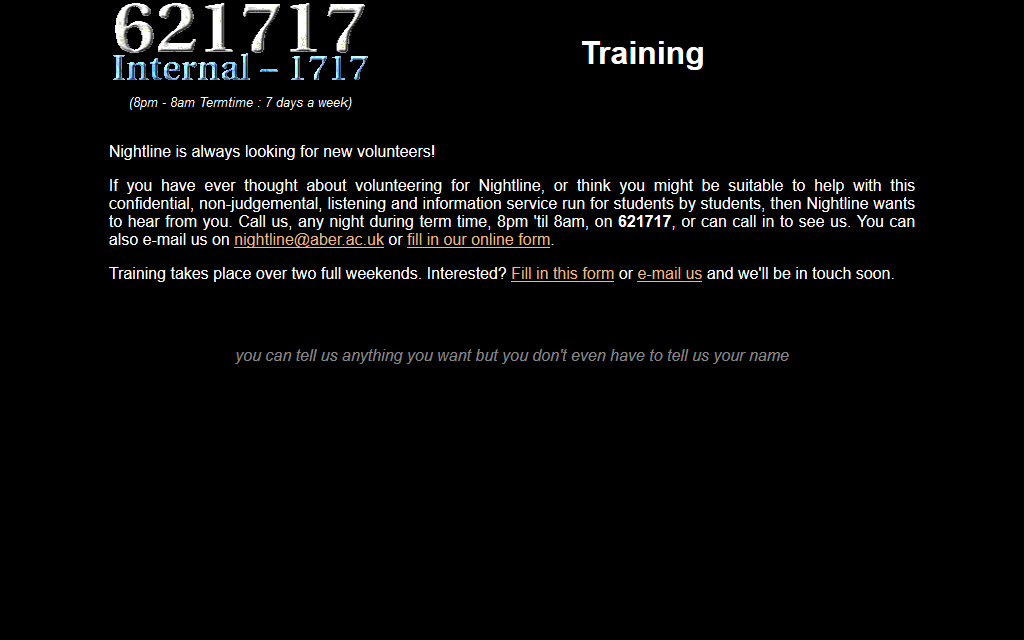
Something I was always particularly interested both at Nightline and in the helplines I volunteered with subsequently was training. At Nightline, I proposed and pushed forward a reimplementation of their traditional training programme that put a far greater focus on experience and practical skills and less on topical presentations. My experience as a trainee and as a helpline volunteer had given me an appreciation of the fundamentals of listening and I wanted future trainees to be able to benefit from this by giving them less time talking about listening and more time practising listening.
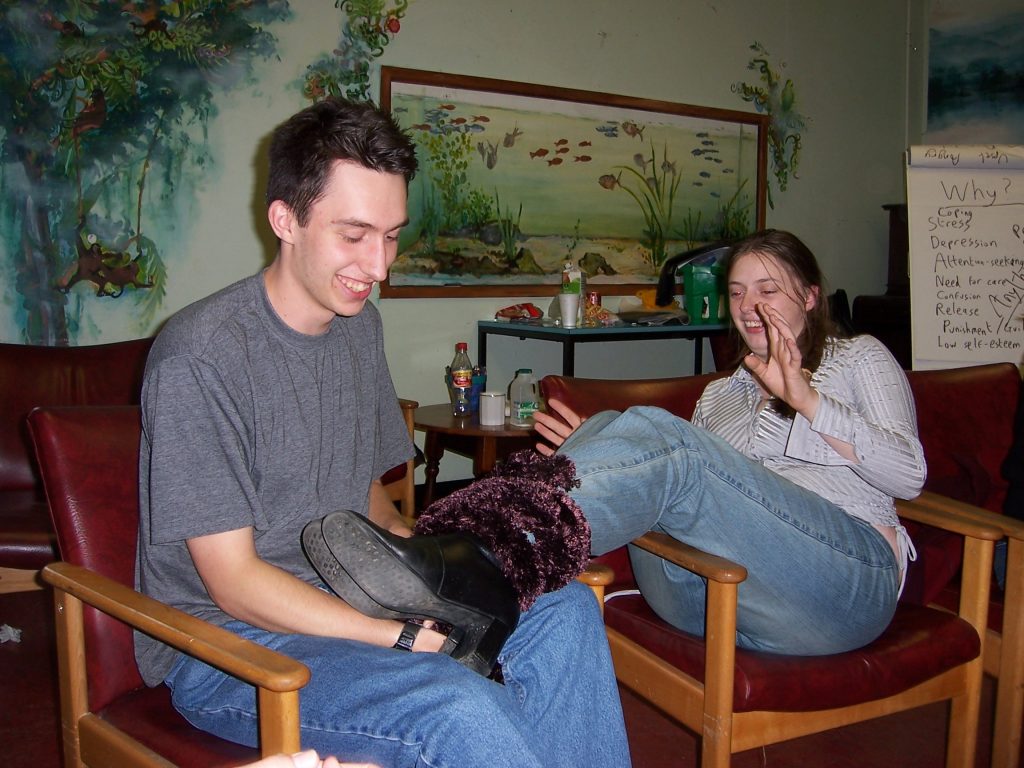
The primary mechanism by which helplines facilitate such practical training is through roleplaying. A trainer will pretend to be a caller and will talk to a trainee, after which the pair (along with any other trainers or trainees who are observing) will debrief and talk about how it went. The only problem with switching wholesale to a roleplay/skills-driven approach to training at Aberystwyth Nightline, as I saw it, was the approach that was historically taken to the generation of roleplay material, which favoured the use of anonymised adaptations of real or imagined calls.
Roleplay scenarios must be realistic (so that they simulate the experience of genuine calls with sufficient accuracy that they are meaningful) but they must also be effective (at promoting the growth of the skills that are needed to best-support callers). Those two criteria often come into conflict in roleplay scenarios: a caller who sits in near-silence for 20 minutes may well be realistic, but there’s a limit to how much you can learn from sitting in silence; a roleplay which tests every facet of a trainee’s practical knowledge provides efficiency, but does not reflect the content of any call that has ever really happened.
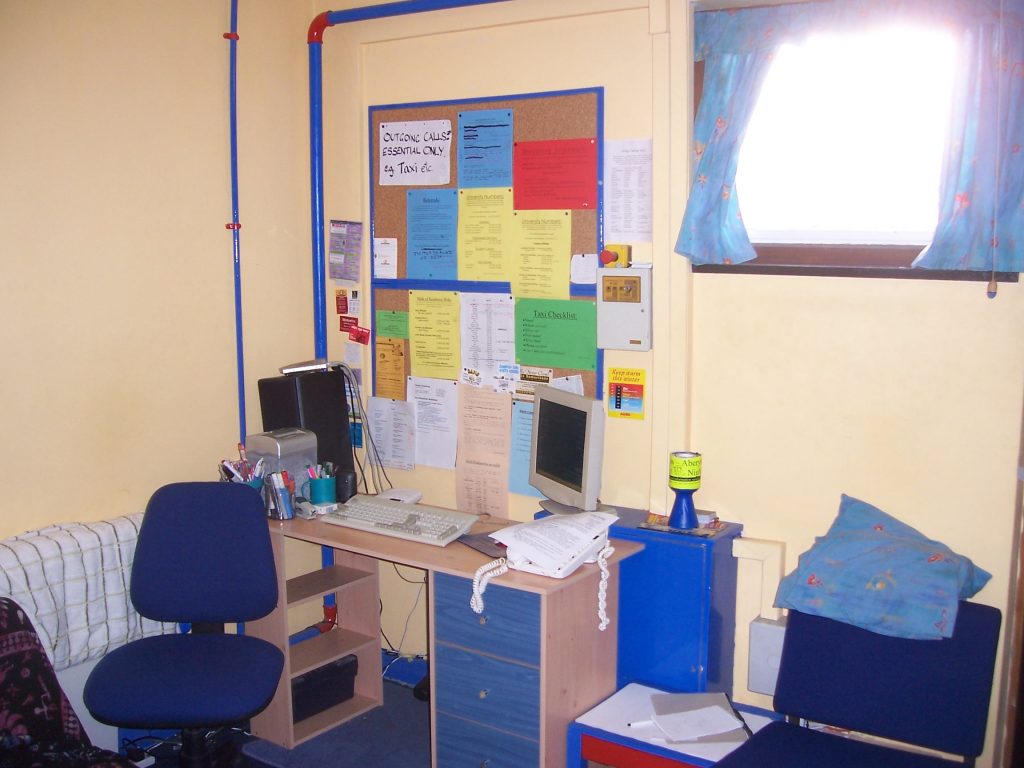
I spent some time outlining the characteristics of best-practice roleplays and providing guidelines to help “train the trainers”. These included ideas, some of which were (then) a little radical, like:
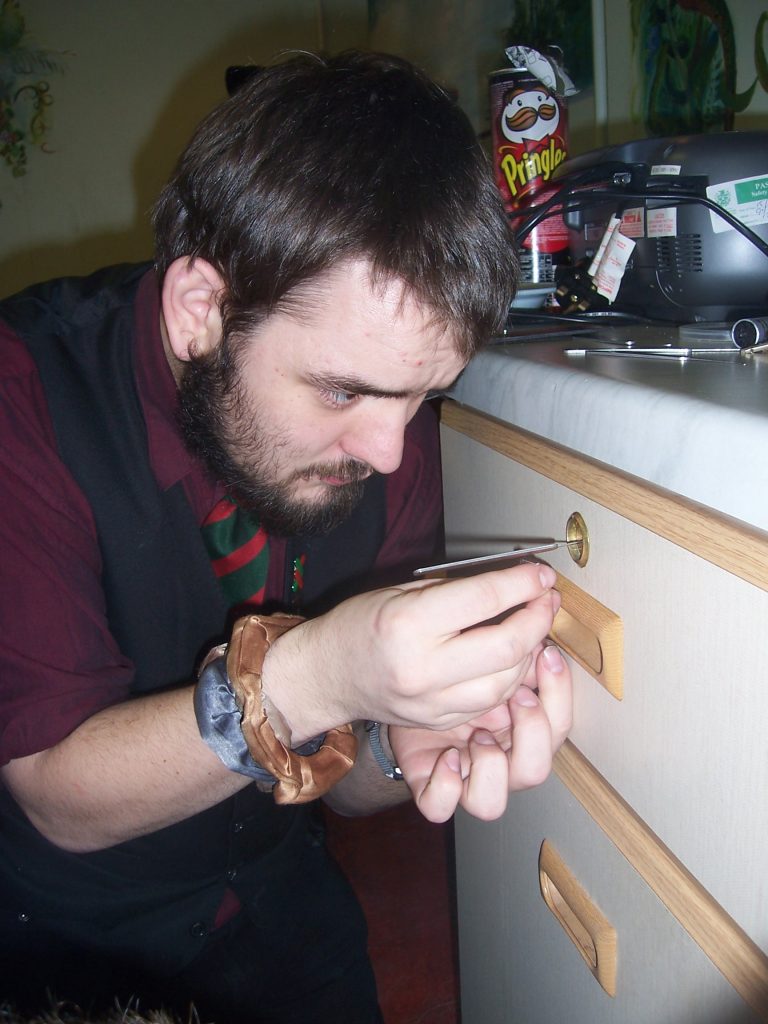
In order to demonstrate the concepts I was promoting, I wrote and demonstrated a significant number of sample roleplay ideas, many of which I (or others) would then go on to flesh-out into full roleplays at training sessions. One of these for which I became well-known was entitled My Friend Scott.
The caller in this roleplay presents with suicidal ideation fuelled by feelings of guilt and loneliness following the accidental death, about six months prior, of his best friend Scott, for which he feels responsible. Scott had been the caller’s best friend since childhood, and he’s fixated on the adventures that they’d had together. He clearly has a huge admiration for his dead friend, bordering on infatuation, and blames himself not only for the death but for the resulting fracturing of their shared friendship group and his subsequent isolation.
(We’re close to getting back to the “Scgary story”, I promise. Hang in here.)
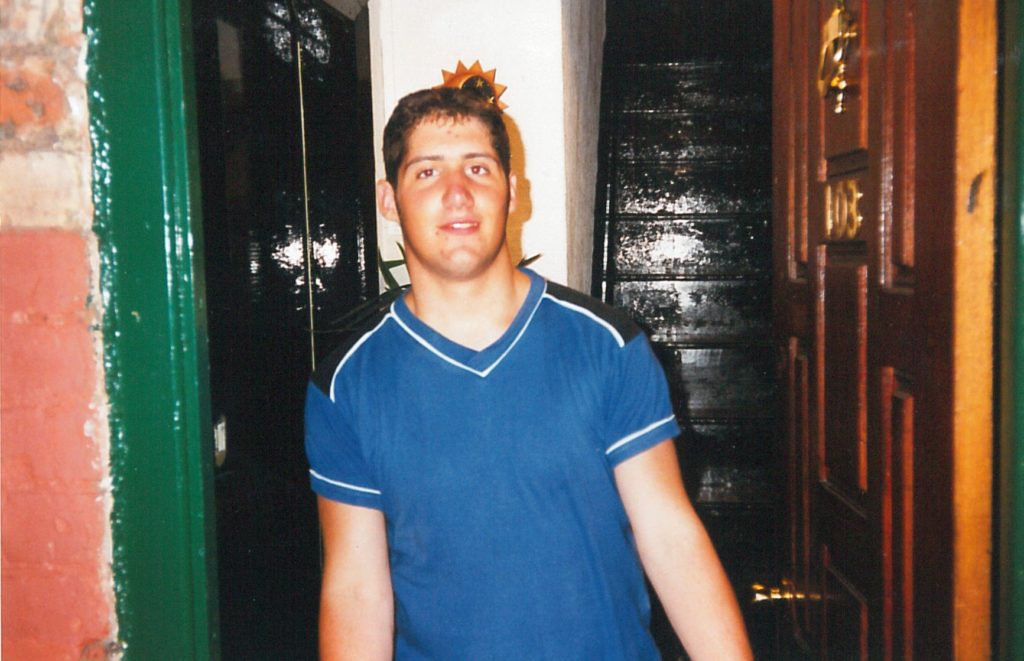
When I would perform this roleplay as the caller, I’d routinely flesh out Scott and the caller’s backstory with anecdotes from my own childhood and early-adulthood: it seemed important to be able to fill in these kinds of details in order to demonstrate how important Scott was to the caller’s life. Things that I really did with any of several of my childhood friends found their way, with or without embellishment, into the roleplay, like:
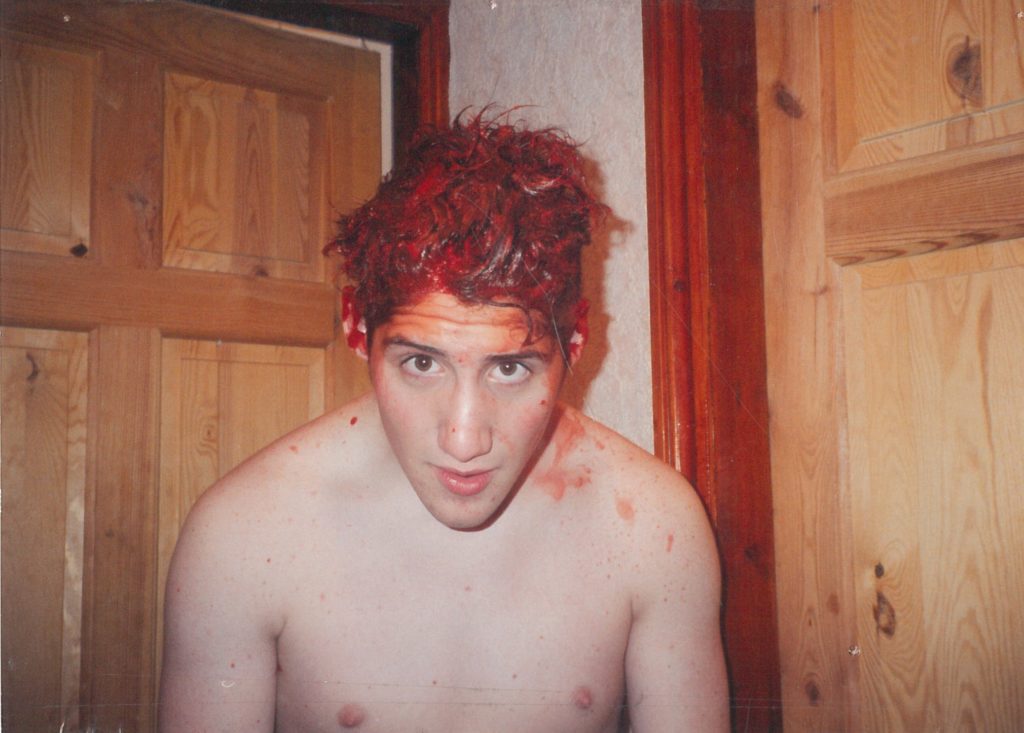
Of course: none of the new Nightliners I trained knew which, if any, of these stories were real – that was never a part of the experience. But many were real, or had a morsel of truth. And a reasonable number of them – four of those in the list above – were things that Gary and I had done together in our youth.
JTA’s surprise came from that strange feeling that occurs when two very parts of your life that you thought were completely separate suddenly and unexpectedly collide with one another (I’m familiar with it). The anecdote that Gary had just shared about our teen years was one that exactly mirrored something he’d heard me say during the My Friend Scott roleplay, and it briefly crashed his brain. Suddenly, this was Scott standing in front of him, and he’d been able to get far enough through his sentence to begin saying that name (“Sc…”) before the crash stopped him in his tracks and he finished off with “…gary”.
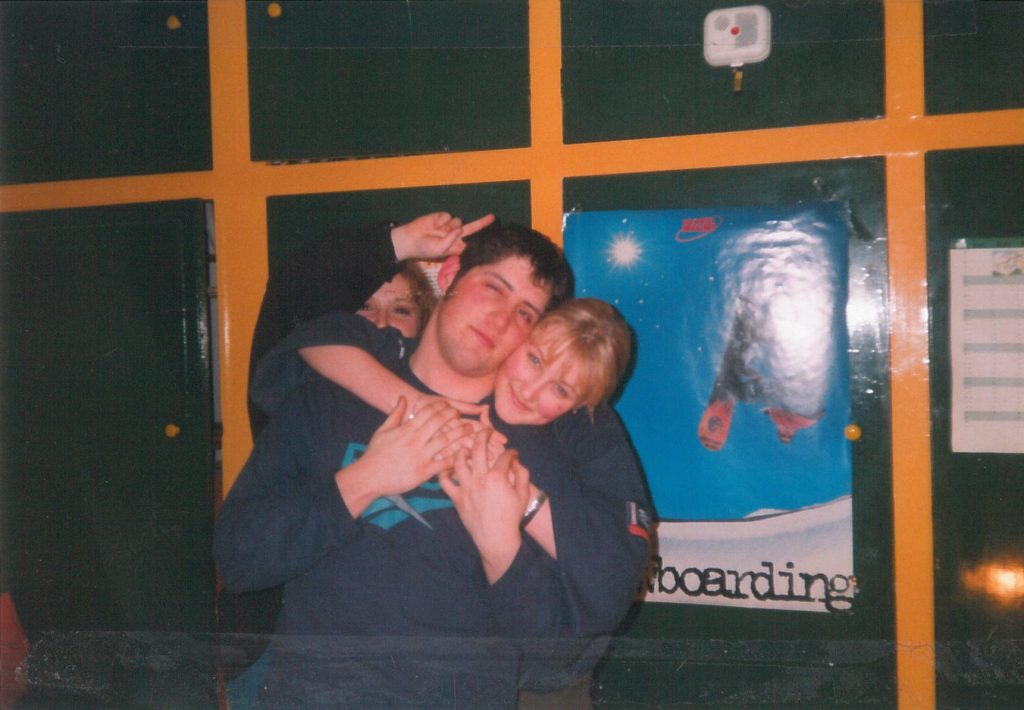
I’m not sure whether or not Gary realises that, in my house at least, he’s to this day been called “Scgary”.
I bumped into him, completely by chance, while visiting my family in Preston this weekend. That reminded me that I’d long planned to tell this story: the story of Scgary, the imaginary person who exists only in the minds of the tiny intersection of people who’ve both (a) met my friend Gary and know about some of the crazy shit we got up to together when we were young and foolish and (b) trained as a volunteer at Aberystwyth Nightline during the window between me overhauling how training was provided and ceasing to be involved with the training programme (as far as I’m aware, nobody is performing My Friend Scott in my absence, but it’s possible…).
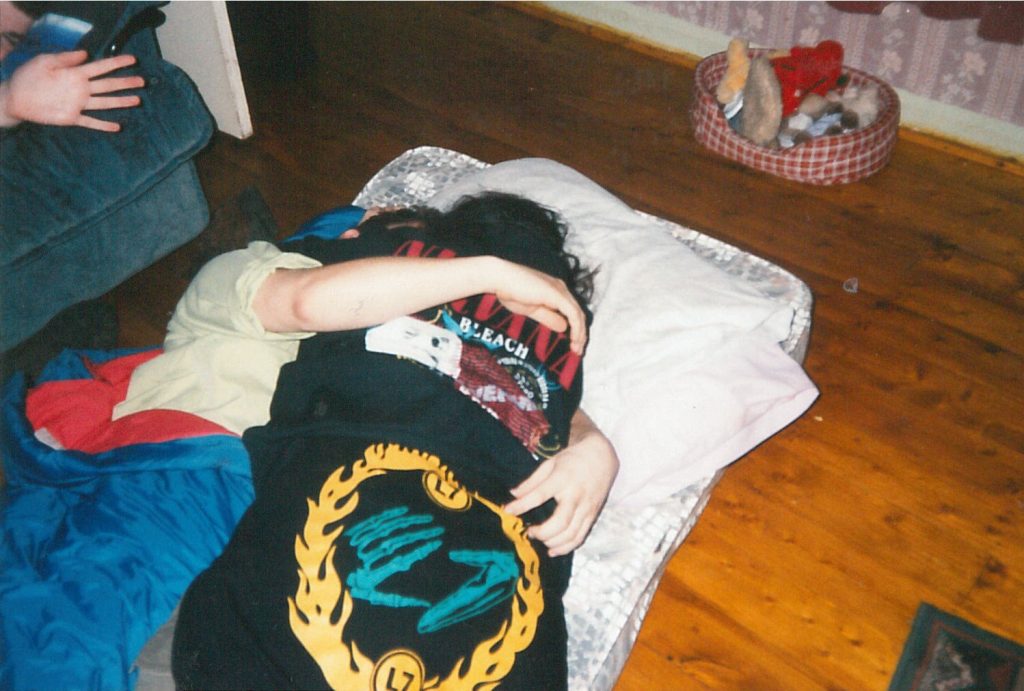
Gary asked me to give him a shout and meet up for a beer next time I’m in his neck of the woods, but it only occurred to me after I said goodbye that I’ve no idea what the best way to reach him is, these days. Like many children of the 80s, I’ve still got the landline phone numbers memorised of all of my childhood friends, but even if that number is still valid, it’d be his parents house!
I guess that I’ll let the Internet do the work for me: perhaps if I write this, here, he’ll find it, somehow. Hi, Scgary!